
RWKV-LM
RWKV (pronounced RwaKuv) is an RNN with great LLM performance, which can also be directly trained like a GPT transformer (parallelizable). We are at RWKV-7 "Goose". So it's combining the best of RNN and transformer - great performance, linear time, constant space (no kv-cache), fast training, infinite ctx_len, and free sentence embedding.
Stars: 13040
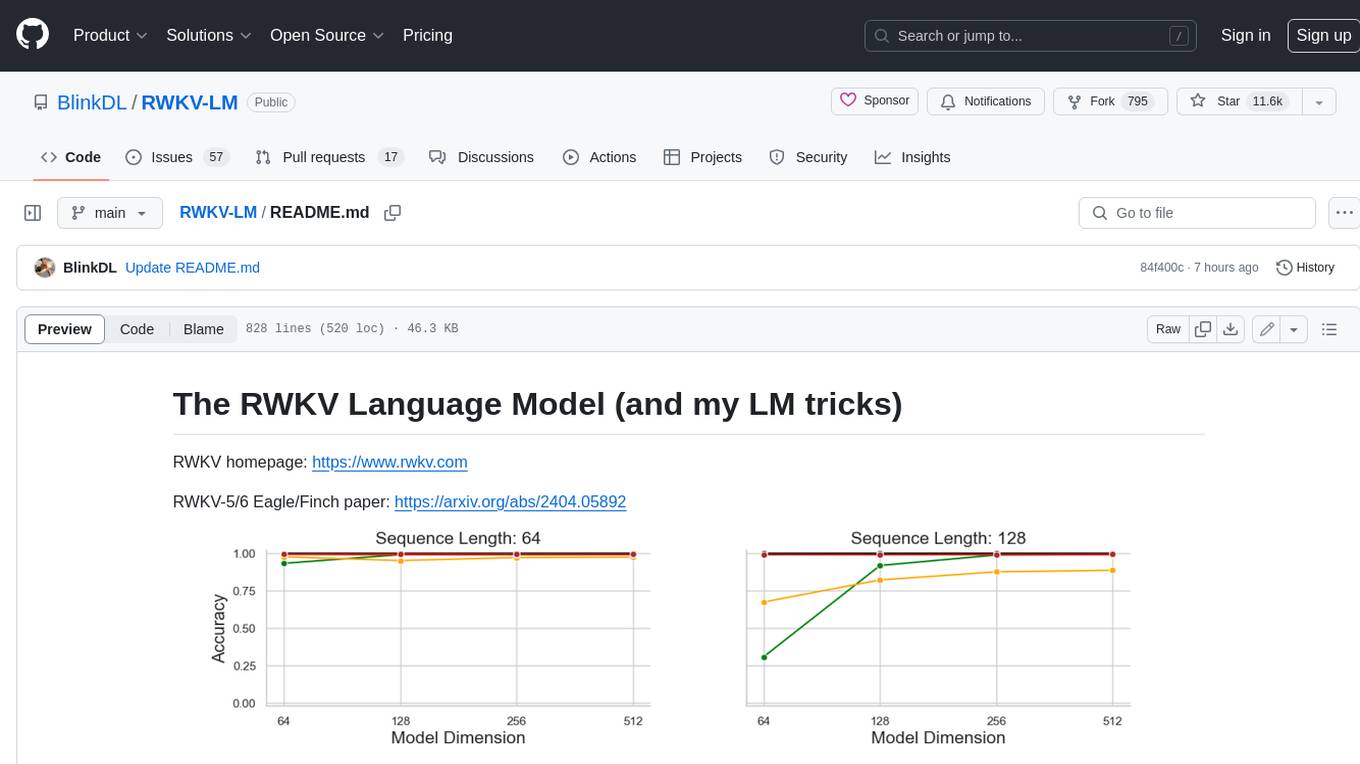
RWKV is an RNN with Transformer-level LLM performance, which can also be directly trained like a GPT transformer (parallelizable). And it's 100% attention-free. You only need the hidden state at position t to compute the state at position t+1. You can use the "GPT" mode to quickly compute the hidden state for the "RNN" mode. So it's combining the best of RNN and transformer - **great performance, fast inference, saves VRAM, fast training, "infinite" ctx_len, and free sentence embedding** (using the final hidden state).
README:
RWKV: Parallelizable RNN with Transformer-level LLM Performance (pronounced as "RwaKuv" (rʌkuv in IPA), from 4 major params: R W K V)
RWKV website: https://rwkv.com (with 30+ RWKV-related papers)
RWKV twitter: https://twitter.com/BlinkDL_AI (lastest news)
RWKV discord: https://discord.gg/bDSBUMeFpc (9k+ members)
RWKV-7 "Goose" is the strongest linear-time & constant-space (no kv-cache) & attention-free & 100% RNN architecture on this planet at this moment, suitable for LLM and multimodal applications and more (see rwkv.com).
VERY IMPORTANT: Use PreLN LayerNorm (instead of RMSNorm) for RWKV. I think it's related to better initial state, because I am not using trainable initial state (found it useless when using LayerNorm).
RWKV-7 is a meta-in-context learner, test-time-training its state on the context via in-context gradient descent at every token.
RWKV is a Linux Foundation AI project, so totally free. RWKV runtime is already in Windows & Office.
You are welcome to ask the RWKV community (such as RWKV discord) for advice on upgrading your attention/ssm models to rwkv7 models :)
RWKV-7 0.1B Demo: https://huggingface.co/spaces/BlinkDL/RWKV-Gradio-1
RWKV-6 7B Demo: https://huggingface.co/spaces/BlinkDL/RWKV-Gradio-2
WebGPU Demo: https://cryscan.github.io/web-rwkv-puzzles/#/chat
Latest RWKV weights: https://huggingface.co/BlinkDL
===
RWKV-Runner GUI: https://github.com/josStorer/RWKV-Runner/releases
Ai00 Server: https://github.com/Ai00-X/ai00_server
RWKV pip pkg: https://pypi.org/project/rwkv/
PEFT (Lora etc.): https://github.com/JL-er/RWKV-PEFT
RLHF: https://github.com/OpenMOSE/RWKV-LM-RLHF
400+ RWKV projects: https://github.com/search?o=desc&q=rwkv&s=updated&type=Repositories
===
RWKV-5/6 Eagle/Finch paper: https://arxiv.org/abs/2404.05892
Chat demo code: https://github.com/BlinkDL/ChatRWKV/blob/main/API_DEMO_CHAT.py
RWKV-7 demo code: https://github.com/BlinkDL/RWKV-LM/tree/main/RWKV-v7
RWKV-6 demo code: https://github.com/BlinkDL/RWKV-LM/blob/main/RWKV-v5/rwkv_v6_demo.py
RWKV-6 demo code: https://github.com/BlinkDL/ChatRWKV/blob/main/RWKV_v6_demo.py
For reference, use python 3.10+, torch 2.5+, cuda 12.5+, latest deepspeed, but keep pytorch-lightning==1.9.5
Train RWKV-7: use /RWKV-v5/ and use --my_testing "x070" in demo-training-prepare.sh and demo-training-run.sh
Train RWKV-6: use /RWKV-v5/ and use --my_testing "x060" in demo-training-prepare.sh and demo-training-run.sh
pip install torch --upgrade --extra-index-url https://download.pytorch.org/whl/cu121
pip install pytorch-lightning==1.9.5 deepspeed wandb ninja --upgrade
cd RWKV-v5/
./demo-training-prepare.sh
./demo-training-run.sh
(you may want to log in to wandb first)
Your loss curve should look almost exactly the same as this, with the same ups and downs (if you use the same bsz & config):
You can run your model using https://pypi.org/project/rwkv/ (use "rwkv_vocab_v20230424" instead of "20B_tokenizer.json")
Use https://github.com/BlinkDL/RWKV-LM/blob/main/RWKV-v5/make_data.py to prepare binidx data from jsonl, and compute "--my_exit_tokens" and "--magic_prime".
Much faster tokenizer of large data: https://github.com/cahya-wirawan/json2bin https://github.com/cahya-wirawan/rwkv-tokenizer https://github.com/m8than/RWKV-World-Tokenizer-CPP
The "epoch" in train.py is "mini-epoch" (not real epoch. only for convenience), and 1 mini-epoch = 40320 * ctx_len tokens.
For example, if your binidx has 1498226207 tokens and ctxlen=4096, set "--my_exit_tokens 1498226207" (this will override epoch_count), and it will be 1498226207/(40320 * 4096) = 9.07 miniepochs. The trainer will auto-exit after "--my_exit_tokens" tokens. Set "--magic_prime" to the largest 3n+2 prime smaller than datalen/ctxlen-1 (= 1498226207/4096-1 = 365776), which is "--magic_prime 365759" in this case.
simple: prepare SFT jsonl => repeat your SFT data 3 or 4 times in make_data.py. more repetition leads to overfitting.
advanced: repeat your SFT data 3 or 4 times in your jsonl (note make_data.py will shuffle all jsonl items) => add some base data (such as slimpajama) to your jsonl => and only repeat 1 times in make_data.py.
Fix training spikes: see the "Fixing RWKV-6 Spikes" part on this page.
Or use RWKV-7 (much better). RWKV-7 is very stable and spike-free (verified for 0.1/0.4/1.5/2.9b):

Simple inference for RWKV-6: https://github.com/BlinkDL/ChatRWKV/blob/main/RWKV_v6_demo.py
Simple inference for RWKV-5: https://github.com/BlinkDL/ChatRWKV/blob/main/RWKV_v5_demo.py
Note: In [state = kv + w * state] everything must be in fp32 because w can be very close to 1. So we can keep state and w in fp32, and convert kv to fp32.
lm_eval: https://github.com/BlinkDL/ChatRWKV/blob/main/run_lm_eval.py
Tips for small model / small data: When I train RWKV music models, I use deep & narrow (such as L29-D512) dimensions, and apply wd and dropout (such as wd=2 dropout=0.02). Note RWKV-LM dropout is very effective - use 1/4 of your usual value.
See https://github.com/BlinkDL/RWKV-LM/blob/main/RWKV-v5/demo-training-prepare-v7-pile.sh and https://github.com/BlinkDL/RWKV-LM/blob/main/RWKV-v5/demo-training-run-v7-pile.sh
Get these files first:
pile_20B_tokenizer_text_document.bin (664230651068 bytes)
pile_20B_tokenizer_text_document.idx (4212099722 bytes)
Use .jsonl format for your data (see https://huggingface.co/BlinkDL/rwkv-5-world for formats).
Use https://github.com/BlinkDL/RWKV-LM/blob/main/RWKV-v5/make_data.py to tokenizer it using World tokenizer into binidx, suitable for finetuning World models.
Rename the base checkpoint in your model folder to rwkv-init.pth, and change the training commands to use --n_layer 32 --n_embd 4096 --vocab_size 65536 --lr_init 1e-5 --lr_final 1e-5 for 7B.
0.1B = --n_layer 12 --n_embd 768 // 0.4B = --n_layer 24 --n_embd 1024 // 1.5B = --n_layer 24 --n_embd 2048 // 3B = --n_layer 32 --n_embd 2560 // 7B = --n_layer 32 --n_embd 4096
Currently unoptimized implementation, takes same vram as full SFT
--train_type "states" --load_partial 1 --lr_init 1 --lr_final 0.01 --warmup_steps 10 (yes, use very high LR)
use rwkv 0.8.26+ to auto-load the trained "time_state"
When you train RWKV from scratch, try my initialization for best performance. Check generate_init_weight() of src/model.py:
emb.weight => nn.init.uniform_(a=-1e-4, b=1e-4)
(Note ln0 of block0 is the layernorm for emb.weight)
head.weight => nn.init.orthogonal_(gain=0.5*sqrt(n_vocab / n_embd))
att.receptance.weight => nn.init.orthogonal_(gain=1)
att.key.weight => nn.init.orthogonal_(gain=0.1)
att.value.weight => nn.init.orthogonal_(gain=1)
att.gate.weight => nn.init.orthogonal_(gain=0.1)
att.output.weight => zero
att.ln_x.weight (groupnorm) => ((1 + layer_id) / total_layers) ** 0.7
ffn.key.weight => nn.init.orthogonal_(gain=1)
ffn.value.weight => zero
ffn.receptance.weight => zero
!!! If you are using positional embedding, maybe it's better to remove block.0.ln0 and use default initialization for emb.weight instead of my uniform_(a=-1e-4, b=1e-4) !!!
-
upgrade to RWKV-7. It's very stable.
-
when training from scratch, add "k = k * torch.clamp(w, max=0).exp()" before "RUN_CUDA_RWKV6(r, k, v, w, u)", and remember to change your inference code too. you will see faster convergence.
-
use "--adam_eps 1e-18"
-
"--beta2 0.95" if you see spikes
-
in trainer.py do "lr = lr * (0.01 + 0.99 * trainer.global_step / w_step)" (originally 0.2 + 0.8), and "--warmup_steps 20"
-
"--weight_decay 0.1" leads to better final loss if you are training lots of data. set lr_final to 1/100 of lr_init when doing this.
RWKV is an RNN with Transformer-level LLM performance, which can also be directly trained like a GPT transformer (parallelizable). And it's 100% attention-free. You only need the hidden state at position t to compute the state at position t+1. You can use the "GPT" mode to quickly compute the hidden state for the "RNN" mode.
So it's combining the best of RNN and transformer - great performance, fast inference, saves VRAM, fast training, "infinite" ctx_len, and free sentence embedding (using the final hidden state).
All latest RWKV weights: https://huggingface.co/BlinkDL
HF-compatible RWKV weights: https://huggingface.co/RWKV
os.environ["RWKV_JIT_ON"] = '1'
os.environ["RWKV_CUDA_ON"] = '0' # if '1' then use CUDA kernel for seq mode (much faster)
from rwkv.model import RWKV # pip install rwkv
model = RWKV(model='/fsx/BlinkDL/HF-MODEL/rwkv-4-pile-1b5/RWKV-4-Pile-1B5-20220903-8040', strategy='cuda fp16')
out, state = model.forward([187, 510, 1563, 310, 247], None) # use 20B_tokenizer.json
print(out.detach().cpu().numpy()) # get logits
out, state = model.forward([187, 510], None)
out, state = model.forward([1563], state) # RNN has state (use deepcopy if you want to clone it)
out, state = model.forward([310, 247], state)
print(out.detach().cpu().numpy()) # same result as abovenanoRWKV: https://github.com/BlinkDL/nanoRWKV (does not require custom CUDA kernel to train, works for any GPU/CPU)
Cool Community RWKV Projects:
All (400+) RWKV projects: https://github.com/search?o=desc&q=rwkv&s=updated&type=Repositories
https://github.com/OpenGVLab/Vision-RWKV Vision RWKV
https://github.com/feizc/Diffusion-RWKV Diffusion RWKV
https://github.com/cgisky1980/ai00_rwkv_server Fastest WebGPU inference (nVidia/AMD/Intel)
https://github.com/cryscan/web-rwkv backend for ai00_rwkv_server
https://github.com/saharNooby/rwkv.cpp Fast CPU/cuBLAS/CLBlast inference: int4/int8/fp16/fp32
https://github.com/JL-er/RWKV-PEFT lora/pissa/Qlora/Qpissa/state tuning
https://github.com/RWKV/RWKV-infctx-trainer Infctx trainer
https://github.com/daquexian/faster-rwkv
https://github.com/mlc-ai/mlc-llm/pull/1275
https://github.com/TheRamU/Fay/blob/main/README_EN.md Digital Assistant with RWKV
https://github.com/harrisonvanderbyl/rwkv-cpp-cuda Fast GPU inference with cuda/amd/vulkan
RWKV v6 in 250 lines (with tokenizer too): https://github.com/BlinkDL/ChatRWKV/blob/main/RWKV_v6_demo.py
RWKV v5 in 250 lines (with tokenizer too): https://github.com/BlinkDL/ChatRWKV/blob/main/RWKV_v5_demo.py
RWKV v4 in 150 lines (model, inference, text generation): https://github.com/BlinkDL/ChatRWKV/blob/main/RWKV_in_150_lines.py
RWKV v4 preprint https://arxiv.org/abs/2305.13048
RWKV v4 introduction, and in 100 lines of numpy: https://johanwind.github.io/2023/03/23/rwkv_overview.html https://johanwind.github.io/2023/03/23/rwkv_details.html
RWKV v6 illustrated:
A cool paper (Spiking Neural Network) using RWKV: https://github.com/ridgerchu/SpikeGPT
You are welcome to join the RWKV discord https://discord.gg/bDSBUMeFpc to build upon it. We have plenty of potential compute (A100 40Gs) now (thanks to Stability and EleutherAI), so if you have interesting ideas I can run them.
RWKV [loss vs token position] for 10000 ctx4k+ documents in Pile. RWKV 1B5-4k is mostly flat after ctx1500, but 3B-4k and 7B-4k and 14B-4k have some slopes, and they are getting better. This debunks the old view that RNNs cannot model long ctxlens. We can predict that RWKV 100B will be great, and RWKV 1T is probably all you need :)
ChatRWKV with RWKV 14B ctx8192:
I believe RNN is a better candidate for fundamental models, because: (1) It's more friendly for ASICs (no kv cache). (2) It's more friendly for RL. (3) When we write, our brain is more similar to RNN. (4) The universe is like an RNN too (because of locality). Transformers are non-local models.
RWKV-3 1.5B on A40 (tf32) = always 0.015 sec/token, tested using simple pytorch code (no CUDA), GPU utilization 45%, VRAM 7823M
GPT2-XL 1.3B on A40 (tf32) = 0.032 sec/token (for ctxlen 1000), tested using HF, GPU utilization 45% too (interesting), VRAM 9655M
Training speed: (new training code) RWKV-4 14B BF16 ctxlen4096 = 114K tokens/s on 8x8 A100 80G (ZERO2+CP). (old training code) RWKV-4 1.5B BF16 ctxlen1024 = 106K tokens/s on 8xA100 40G.
I am doing image experiments too (For example: https://huggingface.co/BlinkDL/clip-guided-binary-autoencoder) and RWKV will be able to do txt2img diffusion :) My idea: 256x256 rgb image -> 32x32x13bit latents -> apply RWKV to compute transition probability for each of the 32x32 grid -> pretend the grids are independent and "diffuse" using these probabilities.
Smooth training - no loss spikes! (lr & bsz change around 15G tokens)

All of the trained models will be open-source. Inference is very fast (only matrix-vector multiplications, no matrix-matrix multiplications) even on CPUs, so you can even run a LLM on your phone.
How it works: RWKV gathers information to a number of channels, which are also decaying with different speeds as you move to the next token. It's very simple once you understand it.
RWKV is parallelizable because the time-decay of each channel is data-independent (and trainable). For example, in usual RNN you can adjust the time-decay of a channel from say 0.8 to 0.5 (these are called "gates"), while in RWKV you simply move the information from a W-0.8-channel to a W-0.5-channel to achieve the same effect. Moreover, you can fine-tune RWKV into a non-parallelizable RNN (then you can use outputs of later layers of the previous token) if you want extra performance.
Here are some of my TODOs. Let's work together :)
-
HuggingFace integration (check https://github.com/huggingface/transformers/issues/17230 ), and optimized CPU & iOS & Android & WASM & WebGL inference. RWKV is a RNN and very friendly for edge devices. Let's make it possible to run a LLM on your phone.
-
Test it on bidirectional & MLM tasks, and image & audio & video tokens. I think RWKV can support Encoder-Decoder via this: for each decoder token, use a learned mixture of [decoder previous hidden state] & [encoder final hidden state]. Hence all decoder tokens will have access to the encoder output.
-
Now training RWKV-4a with one single tiny extra attention (just a few extra lines comparing with RWKV-4) to further improve some difficult zeroshot tasks (such as LAMBADA) for smaller models. See https://github.com/BlinkDL/RWKV-LM/commit/a268cd2e40351ee31c30c5f8a5d1266d35b41829
User feedback:
I've so far toyed around the character-based model on our relatively small pre-training dataset (around 10GB of text), and the results are extremely good - similar ppl to models taking much, much longer to train.
dear god rwkv is fast. i switched to another tab after starting training it from scratch & when i returned it was emitting plausible english & maori words, i left to go microwave some coffee & when i came back it was producing fully grammatically correct sentences.
Tweet from Sepp Hochreiter (thank you!): https://twitter.com/HochreiterSepp/status/1524270961314484227
You can find me (BlinkDL) in the EleutherAI Discord too: https://www.eleuther.ai/get-involved/
IMPORTANT: Use deepspeed==0.7.0 pytorch-lightning==1.9.5 torch==1.13.1+cu117 and cuda 11.7.1 or 11.7 (note torch2 + deepspeed has weird bugs and hurts model performance)
Use https://github.com/BlinkDL/RWKV-LM/tree/main/RWKV-v4neo (latest code, compatible with v4).
Here is a great prompt for testing Q&A of LLMs. Works for any model: (found by minimizing ChatGPT ppls for RWKV 1.5B)
prompt = f'\nQ & A\n\nQuestion:\n{qq}\n\nDetailed Expert Answer:\n' # let the model generate after thisRun RWKV-4 Pile models: Download models from https://huggingface.co/BlinkDL. Set TOKEN_MODE = 'pile' in run.py and run it. It's fast even on CPU (the default mode).
Colab for RWKV-4 Pile 1.5B: https://colab.research.google.com/drive/1F7tZoPZaWJf1fsCmZ5tjw6sYHiFOYVWM
Run RWKV-4 Pile models in your browser (and onnx version): see this issue https://github.com/BlinkDL/RWKV-LM/issues/7
RWKV-4 Web Demo: https://josephrocca.github.io/rwkv-v4-web/demo/ (note: only greedy sampling for now)
For the old RWKV-2: see the release here for a 27M params model on enwik8 with 0.72 BPC(dev). Run run.py in https://github.com/BlinkDL/RWKV-LM/tree/main/RWKV-v2-RNN. You can even run it in your browser: https://github.com/BlinkDL/AI-Writer/tree/main/docs/eng https://blinkdl.github.io/AI-Writer/eng/ (this is using tf.js WASM single-thread mode).
pip install deepspeed==0.7.0 // pip install pytorch-lightning==1.9.5 // torch 1.13.1+cu117
NOTE: add weight decay (0.1 or 0.01) and dropout (0.1 or 0.01) when training on small amt of data. try x=x+dropout(att(x)) x=x+dropout(ffn(x)) x=dropout(x+att(x)) x=dropout(x+ffn(x)) etc.
Training RWKV-4 from scratch: run train.py, which by default is using the enwik8 dataset (unzip https://data.deepai.org/enwik8.zip).
You will be training the "GPT" version because it's paralleziable and faster to train. RWKV-4 can extrapolate, so training with ctxLen 1024 can work for ctxLen of 2500+. You can fine-tune the model with longer ctxLen and it can quickly adapt to longer ctxLens.
Fine-tuning RWKV-4 Pile models: use 'prepare-data.py' in https://github.com/BlinkDL/RWKV-v2-RNN-Pile/tree/main/RWKV-v3 to tokenize .txt into train.npy data. Then use https://github.com/BlinkDL/RWKV-LM/blob/main/RWKV-v4neo/train.py to train it.
Read the inference code in src/model.py and try using the final hidden state(.xx .aa .bb) as a faithful sentence embedding for other tasks. Probably you should begin with .xx and .aa/.bb (.aa divided by .bb).
Colab for fine-tuning RWKV-4 Pile models: https://colab.research.google.com/github/resloved/RWKV-notebooks/blob/master/RWKV_v4_RNN_Pile_Fine_Tuning.ipynb
Large corpus: Use https://github.com/Abel2076/json2binidx_tool to convert .jsonl into .bin and .idx
The jsonl format sample (one line for each document):
{"text": "This is the first document."}
{"text": "Hello\nWorld"}
{"text": "1+1=2\n1+2=3\n2+2=4"}
generated by code like this:
ss = json.dumps({"text": text}, ensure_ascii=False)
out.write(ss + "\n")
Infinite ctxlen training (WIP): https://github.com/Blealtan/RWKV-LM-LoRA/tree/dev-infctx
How to use RWKV hidden state as text embedding
Consider RWKV 14B. The state has 200 vectors, that is, 5 vectors for each block: fp16 (xx), fp32 (aa), fp32 (bb), fp32 (pp), fp16 (xx).
Do not avg pool because different vectors (xx aa bb pp xx) in the state have very different meanings and ranges. You can probably remove pp.
I suggest firstly collect the mean+stdev statistics of each channel of each vector, and normalize all of them (note: the normalization should be data-indepedent and collected from various texts). Then train a linear classifer.
RWKV-5 is multi-head and here shows one head. There is also a LayerNorm for each head (hence actually GroupNorm).
$ \begin{array}{|l|l|l|} \hline & \text { RWKV-4 with real-valued } k \,\&\, v \,\&\, u \,\&\, w & \text { RWKV-5 with matrix-valued } \mathrm{k}^{\dagger} \mathrm{v} \,\&\, \mathrm{u} \,\&\, \mathrm{w} \\ \hline \mathrm{y}_0 & \mathrm{r}_0 \frac{\mathrm{uk}_0 \mathrm{v}_0}{\mathrm{uk}_0} & \mathrm{r}_0\left(\mathrm{uk}_0^{\dagger} \mathrm{v}_0\right) \\ \hline \mathrm{y}_1 & \mathrm{r}_1 \frac{\mathrm{uk}_1 \mathrm{v}_1+\mathrm{k}_0 \mathrm{v}_0}{\mathrm{uk}_1+\mathrm{k}_0} & \mathrm{r}_1\left(\mathrm{uk}_1^{\dagger} \mathrm{v}_1+\mathrm{k}_0^{\dagger} \mathrm{v}_0\right) \\ \hline \mathrm{y}_2 & \mathrm{r}_2 \frac{\mathrm{uk}_2 \mathrm{v}_2+\mathrm{k}_1 \mathrm{v}_1+\mathrm{wk}_0 \mathrm{v}_0}{\mathrm{uk}_2+\mathrm{k}_1+\mathrm{wk}_0} & \mathrm{r}_2\left(\mathrm{uk}_2^{\dagger} \mathrm{v}_2+\mathrm{k}_1^{\dagger} \mathrm{v}_1+\mathrm{wk}_0^{\dagger} \mathrm{v}_0\right) \\ \hline \mathrm{y}_3 & \mathrm{r}_3 \frac{\mathrm{uk}_3 \mathrm{v}_3+\mathrm{k}_2 \mathrm{v}_2+\mathrm{wk}_1 \mathrm{v}_1+\mathrm{w}^2 \mathrm{k}_0 \mathrm{v}_0}{\mathrm{uk}_3+\mathrm{k}_2+\mathrm{wk}_1+\mathrm{w}^2 \mathrm{k}_0} & \mathrm{r}_3\left(\mathrm{uk}_3^{\dagger} \mathrm{v}_3+\mathrm{k}_2^{\dagger} \mathrm{v}_2+\mathrm{wk}_1^{\dagger} \mathrm{v}_1+\mathrm{w}^2 \mathrm{k}_0^{\dagger} \mathrm{v}_0\right) \\ \hline \end{array}$
$\left[\begin{array}{ll} \mathrm{y}_{20} & \cdots \mathrm{y}_{2 \mathrm{c}} \end{array}\right]=\left[\begin{array}{lll} \mathrm{r}_{20} & \cdots & \mathrm{r}_{2 \mathrm{c}} \end{array}\right]$
$\left(\left[\begin{array}{ccc} \mathrm{u}_{00} & \cdots & \mathrm{u}_{0 \mathrm{c}} \\ \vdots & \ddots & \vdots \\ \mathrm{u}_{\mathrm{c} 0} & \cdots & \mathrm{u}_{\mathrm{cc}} \end{array}\right]\left[\begin{array}{ccc} \mathrm{k}_{20} \mathrm{v}_{20} & \cdots & \mathrm{k}_{20} \mathrm{v}_{2 \mathrm{c}} \\ \vdots & \ddots & \vdots \\ \mathrm{k}_{2 \mathrm{c}} \mathrm{v}_{20} & \cdots & \mathrm{k}_{2 \mathrm{c}} \mathrm{v}_{2 \mathrm{c}} \end{array}\right]+\left[\begin{array}{ccc} \mathrm{k}_{10} \mathrm{v}_{10} & \cdots & \mathrm{k}_{10} \mathrm{v}_{1 \mathrm{c}} \\ \vdots & \ddots & \vdots \\ \mathrm{k}_{1 \mathrm{c}} \mathrm{v}_{10} & \cdots & \mathrm{k}_{1 \mathrm{c}} \mathrm{v}_{1 \mathrm{c}} \end{array}\right]+\left[\begin{array}{ccc} \mathrm{w}_{00} & \cdots & \mathrm{w}_{0 \mathrm{c}} \\ \vdots & \ddots & \vdots \\ \mathrm{w}_{\mathrm{c} 0} & \cdots & \mathrm{w}_{\mathrm{cc}} \end{array}\right]\left[\begin{array}{ccc} \mathrm{k}_{00} \mathrm{v}_{00} & \cdots & \mathrm{k}_{00} \mathrm{v}_{0 c} \\ \vdots & \ddots & \vdots \\ \mathrm{k}_{0 \mathrm{c}} \mathrm{v}_{00} & \cdots & \mathrm{k}_{0 \mathrm{c}} \mathrm{v}_{0 c} \end{array}\right] \right)$
Dynamic Mix & Dynamic Decay. Example (do this for both TimeMix & ChannelMix):
TIME_MIX_EXTRA_DIM = 32
self.time_mix_k_w1 = nn.Parameter(torch.empty(args.n_embd, TIME_MIX_EXTRA_DIM).uniform_(-0.01, 0.01))
self.time_mix_k_w2 = nn.Parameter(torch.zeros(TIME_MIX_EXTRA_DIM, args.n_embd))
self.time_mix_v_w1 = nn.Parameter(torch.empty(args.n_embd, TIME_MIX_EXTRA_DIM).uniform_(-0.01, 0.01))
self.time_mix_v_w2 = nn.Parameter(torch.zeros(TIME_MIX_EXTRA_DIM, args.n_embd))
self.time_mix_r_w1 = nn.Parameter(torch.empty(args.n_embd, TIME_MIX_EXTRA_DIM).uniform_(-0.01, 0.01))
self.time_mix_r_w2 = nn.Parameter(torch.zeros(TIME_MIX_EXTRA_DIM, args.n_embd))
self.time_mix_g_w1 = nn.Parameter(torch.empty(args.n_embd, TIME_MIX_EXTRA_DIM).uniform_(-0.01, 0.01))
self.time_mix_g_w2 = nn.Parameter(torch.zeros(TIME_MIX_EXTRA_DIM, args.n_embd))
...
time_mix_k = self.time_mix_k.view(1,1,-1) + (x @ self.time_mix_k_w1) @ self.time_mix_k_w2
time_mix_v = self.time_mix_v.view(1,1,-1) + (x @ self.time_mix_v_w1) @ self.time_mix_v_w2
time_mix_r = self.time_mix_r.view(1,1,-1) + (x @ self.time_mix_r_w1) @ self.time_mix_r_w2
time_mix_g = self.time_mix_g.view(1,1,-1) + (x @ self.time_mix_g_w1) @ self.time_mix_g_w2
xx = self.time_shift(x)
xk = x * time_mix_k + xx * (1 - time_mix_k)
xv = x * time_mix_v + xx * (1 - time_mix_v)
xr = x * time_mix_r + xx * (1 - time_mix_r)
xg = x * time_mix_g + xx * (1 - time_mix_g)
Use parallelized mode to quickly generate the state, then use a finetuned full RNN (the layers of token n can use outputs of all layer of token n-1) for sequential generation.
-
Now time decay is like 0.999^T (0.999 is learnable). Change it to something like (0.999^T + 0.1) where 0.1 is learnable too. The 0.1 part will be kept forever. Or, A^T + B^T + C = fast-decay + slow-decay + constant. Can even use different formulas (for example, K^2 instead of e^K for a decay component, or, without normalization).
-
Use complex-valued decay (so, rotation instead of decay) in some channels.
-
Inject some trainable and extrapolatable positional encoding?
-
Aside from 2d rotation, we can try other Lie groups such as 3d rotation ( SO(3) ). Non-abelian RWKV lol.
-
RWKV might be great on analog devices (search for Analog Matrix-vector multiplication & Photonic Matrix-vector multiplication). The RNN mode is very hardware-friendly (processing-in-memory). Can be a SNN too (https://github.com/ridgerchu/SpikeGPT). I wonder if it can be optimized for quantum computation.
-
Trainable initial hidden state (xx aa bb pp xx).
-
Layerwise (or even row/column-wise, elementwise) LR, and test Lion optimizer.
- I find it's good to add a 2d pos encoding:
self.pos_emb_x = nn.Parameter(torch.zeros((1,args.my_pos_emb,args.n_embd)))
self.pos_emb_y = nn.Parameter(torch.zeros((args.my_pos_emb,1,args.n_embd)))
...
x = x + pos_emb_x + pos_emb_y
- In a BPE langauge model, it's the best to use [tokenShift of 1 token] (you can mix more tokens in a char-level English model). However you can try [tokenShift of N (or N-1) (or N+1) tokens] if the image size is N x N, because that will be like mixing [the token above the current positon (or the token above the to-be-predicted positon)] with [current token]. You can use try different tokenShift styles for "ATT" & "FFN", or mixing different tokenShift styles - such as mixing [token A] with [token A-1] and [token A-(N-1)] etc.
Maybe we can improve memorization by simply repeating the context (I guess 2 times is enough). Example: Reference -> Reference(again) -> Question -> Answer
The idea is to make sure each token in vocab understand its length and raw UTF-8 bytes.
Let a = max(len(token)) for all token in vocab. Define AA : float[a][d_emb]
Let b = max(len_in_utf8_bytes(token)) for all token in vocab. Define BB : float[b][256][d_emb]
For each token X in vocab, let [x0, x1, ..., xn] be its raw UTF-8 bytes. We will add some extra values to its embedding EMB(X):
EMB(X) += AA[len(X)] + BB[0][x0] + BB[1][x1] + ... + BB[n][xn] (note: AA BB are learnable weights)
- We can do this for the final Linear(d_emb, n_vocab) projection too.
- We can use some small networks to generate AA and BB, for some extra regularization (for example, BB[m][xi] and BB[n][xi] should be related).
I have an idea to improve tokenization. We can hardcode some channels to have meanings. Example:
Channel 0 = "space"
Channel 1 = "capitalize first letter"
Channel 2 = "capitalize all letters"
Therefore:
Embedding of "abc": [0, 0, 0, x0, x1, x2 , ..]
Embedding of " abc": [1, 0, 0, x0, x1, x2, ..]
Embedding of " Abc": [1, 1, 0, x0, x1, x2, ..]
Embedding of "ABC": [0, 0, 1, x0, x1, x2, ...]
......
so they will share most of the embedding. And we can rapidly compute the output probability of all variations of "abc".
Note: the above method is assuming that p(" xyz") / p("xyz") is the same for any "xyz", which can be wrong.
Better: define emb_space emb_capitalize_first emb_capitalize_all to be a function of emb.
Maybe the Best: let 'abc' ' abc' etc. to share the last 90% of their embeddings.
At this moment, all our tokenizers spend too many items to represent all variations of 'abc' ' abc' ' Abc' etc. Moreover the model cannot discover that these are actually similar if some of these variations are rare in the dataset. The method here can improve this. I plan to test this in a new version of RWKV.
Example (single-round Q & A):
-
Generate the final state of all wiki documents.
-
For any user Q, find the best wiki document, and use its final state as the initial state.
-
Train a model to directly generate the optimal initial state for any user Q.
However this can be a bit more tricky for multi-round Q & A :)
RWKV is inspired by Apple's AFT (https://arxiv.org/abs/2105.14103).
Moreover it's using a number of my tricks, such as:
-
SmallInitEmb: https://github.com/BlinkDL/SmallInitEmb (applicable to all transformers) which helps the embedding quality, and stabilizes Post-LN (which is what I am using).
-
Token-shift: https://github.com/BlinkDL/RWKV-LM#token-shift-time-shift-mixing (applicable to all transformers), especially helpful for char-level models.
-
Head-QK: https://github.com/BlinkDL/RWKV-LM#the-head-qk-trick-learning-to-copy-and-avoid-tokens (applicable to all transformers). Note: it's helpful, but I disabled it in the Pile model to keep it 100% RNN.
-
Extra R-gate in the FFN (applicable to all transformers). I am also using reluSquared from Primer.
-
Better initilization: I init most of the matrices to ZERO (see RWKV_Init in https://github.com/BlinkDL/RWKV-LM/blob/main/RWKV-v2-RNN/src/model.py).
-
You can transfer some parameters from a small model to a large model (note: I sort & smooth them too), for faster and better convergence (see https://www.reddit.com/r/MachineLearning/comments/umq908/r_rwkvv2rnn_a_parallelizable_rnn_with/).
-
My CUDA kernel: https://github.com/BlinkDL/RWKV-CUDA to speedup training.
The a b c d factors work together to build a time-decay curve: [X, 1, W, W^2, W^3, ...].
Write out the formulas for "token at pos 2" and "token at pos 3" and you will get the idea:
- a and b: EMAs of kv and k.
- c and d: these are a and b combined with "self-attention".
kv / k is the memory mechanism. The token with high k can be remembered for a long duration, if W is close to 1 in the channel.
The R-gate is important for performance. k = info strength of this token (to be passed to future tokens). r = whether to apply the info to this token.
Use different trainable TimeMix factors for R / K / V in SA and FF layers. Example:
xx = self.time_shift(x)
xk = x * self.time_mix_k + xx * (1 - self.time_mix_k)
xv = x * self.time_mix_v + xx * (1 - self.time_mix_v)
xr = x * self.time_mix_r + xx * (1 - self.time_mix_r)Use preLN instead of postLN (more stable & faster convergence):
if self.layer_id == 0:
x = self.ln0(x)
x = x + self.att(self.ln1(x))
x = x + self.ffn(self.ln2(x))The building blocks of RWKV-3 GPT mode are similar to that of a usual preLN GPT.
The only difference is an extra LN after embedding. Note you can absorb this LN into the embedding after finishing the training.
x = self.emb(idx) # input: idx = token indices
x = self.ln_emb(x) # extra LN after embedding
x = x + self.att_0(self.ln_att_0(x)) # preLN
x = x + self.ffn_0(self.ln_ffn_0(x))
...
x = x + self.att_n(self.ln_att_n(x))
x = x + self.ffn_n(self.ln_ffn_n(x))
x = self.ln_head(x) # final LN before projection
x = self.head(x) # output: x = logitsIt is important to initialize emb to tiny values, such as nn.init.uniform_(a=-1e-4, b=1e-4), to utilize my trick https://github.com/BlinkDL/SmallInitEmb.
For the 1.5B RWKV-3, I use Adam (no wd, no dropout) optimizer on 8 * A100 40G.
batchSz = 32 * 896, ctxLen = 896. I am using tf32 so the batchSz is a bit small.
For the first 15B tokens, LR is fixed at 3e-4, and beta=(0.9, 0.99).
Then I set beta=(0.9, 0.999), and do an exponential decay of LR, reaching 1e-5 at 332B tokens.
The RWKV-3 does not have any attention in the usual sense, but we will call this block ATT anyway.
B, T, C = x.size() # x = (Batch,Time,Channel)
# Mix x with the previous timestep to produce xk, xv, xr
xx = self.time_shift(x) # self.time_shift = nn.ZeroPad2d((0,0,1,-1))
xk = x * self.time_mix_k + xx * (1 - self.time_mix_k)
xv = x * self.time_mix_v + xx * (1 - self.time_mix_v)
xr = x * self.time_mix_r + xx * (1 - self.time_mix_r)
# Use xk, xv, xr to produce k, v, r
k = self.key(xk).transpose(-1, -2)
v = self.value(xv).transpose(-1, -2)
r = self.receptance(xr)
k = torch.clamp(k, max=60) # clamp k to avoid overflow
k = torch.exp(k)
kv = k * v
# Compute the W-curve = [e^(-n * e^time_decay), e^(-(n-1) * e^time_decay), ..., 1, e^(time_first)]
self.time_w = torch.cat([torch.exp(self.time_decay) * self.time_curve.to(x.device), self.time_first], dim=-1)
w = torch.exp(self.time_w)
# Use W to mix kv and k respectively. Add K_EPS to wk to avoid divide-by-zero
if RUN_DEVICE == 'cuda':
wkv = TimeX.apply(w, kv, B,C,T, 0)
wk = TimeX.apply(w, k, B,C,T, K_EPS)
else:
w = w[:,-T:].unsqueeze(1)
wkv = F.conv1d(nn.ZeroPad2d((T-1, 0, 0, 0))(kv), w, groups=C)
wk = F.conv1d(nn.ZeroPad2d((T-1, 0, 0, 0))(k), w, groups=C) + K_EPS
# The RWKV formula
rwkv = torch.sigmoid(r) * (wkv / wk).transpose(-1, -2)
rwkv = self.output(rwkv) # final output projectionThe self.key, self.receptance, self.output matrices are all initialized to zero.
The time_mix, time_decay, time_first vectors are transferred from a smaller trained model (note: I sort & smooth them too).
The FFN block has three tricks comparing with the usual GPT:
-
My time_mix trick.
-
The sqReLU from the Primer paper.
-
An extra receptance-gate (similar to the receptance-gate in ATT block).
# Mix x with the previous timestep to produce xk, xr
xx = self.time_shift(x)
xk = x * self.time_mix_k + xx * (1 - self.time_mix_k)
xr = x * self.time_mix_r + xx * (1 - self.time_mix_r)
# The usual FFN operation
k = self.key(xk)
k = torch.square(torch.relu(k)) # from the Primer paper
kv = self.value(k)
# Apply an extra receptance-gate to kv
rkv = torch.sigmoid(self.receptance(xr)) * kv
return rkvThe self.value, self.receptance matrices are all initialized to zero.
Let F[t] be the system state at t.
Let x[t] be the new external input at t.
In GPT, predicting F[t+1] requires considering F[0], F[1], .. F[t]. So it takes O(T^2) to generate a length T sequence.
The simplified formula for GPT:
It's very capable in theory, however that does not mean we can fully utilize its capability with usual optimizers. I suspect the loss landscape is too difficult for our current methods.
Compare with the simplified formula for RWKV (the parallel mode, looks similar to Apple's AFT):
The R, K, V are trainable matrices, and W is a trainable vector (time-decay factor for each channel).
In GPT, the contribution of F[i] to F[t+1] is weighted by .
In RWKV-2, the contribution of F[i] to F[t+1] is weighted by .
- The
is a non-linearity and we can use sigmoid.
- Note
is not in the denominator, and I call R the "receptance".
- The
is the time-decay factor. I proposed the same idea (scaling the attention by distance) in Aug 2020 and called it the "time-weighting" (check the commit history of https://github.com/BlinkDL/minGPT-tuned).
Here comes the punchline: we can rewrite it into a RNN (recursive formula). Note:
Therefore it's straightforward to verify:
where A[t] and B[t] are the numerator and denominator of the previous step, respectively.
I believe RWKV is performant because W is like repeatedly applying a diagonal matrix. Note (P^{-1} D P)^n = P^{-1} D^n P, so it is similar to repeatedly applying a general diagonalizable matrix.
Moreover it's possible to turn it into a continuous ODE (a bit similar to State Space Models). I will write about it later.
I have an idea for [text --> 32x32 RGB image] using a LM (transformer, RWKV, etc.). Will test it soon.
Firstly, LM loss (instead of L2 loss), so the image will not be blurry.
Secondly, color quantization. For example, only allowing 8 levels for R/G/B. Then the image vocab size is 8x8x8 = 512 (for each pixel), instead of 2^24. Therefore, a 32x32 RGB image = a len1024 sequence of vocab512 (image tokens), which is a typical input for usual LMs. (Later we can use diffusion models to upsample and generate RGB888 images. We might be able to use a LM for this too.)
Thirdly, 2D positional embeddings that are easy for the model to understand. For example, add one-hot X & Y coords to the first 64(=32+32) channels. Say if the pixel is at x=8, y=20, then we will add 1 to channel 8 and channel 52 (=32+20). Moreover probably we can add the float X & Y coords (normalized to 0~1 range) to another 2 channels. And other periodic pos. encoding might help too (will test).
Finally, RandRound when doing the color quantization in the DataLoader. For example, if the float level is 4.578, then there is a 57.8% chance to use 5, and (1-57.8%) chance to use 4. And we can allow both 4 and 5 in the prediction, but the loss will be higher if the prediction is 4.
Multi-task training might help too. I will try this dataset format: [TxtFirst] [Desc of Img (txt tokens)] [Img] [img tokens] and sometimes [ImgFirst] [img tokens] [Txt] [Desc of Img (txt tokens)] ... the order of the imgs should be randomized in the DataLoader, and [TxtFirst] [ImgFirst] [Img] [Txt] are special tokens and do random sampling of the full dataset. So sometimes the model will see the img tokens first and then the corresponding txt tokens, which is a [img -> txt] task. And the model will see some partial imgs and partial txts. I think a char-level LM might help the model to write correct text on images.
I am using a trick to sample the Pile deterministically yet randomly enough.
Let's say the pile has x chunks (a chunk = ctx_len tokens).
pick a prime number p just less than x, and make sure p = 2 (mod 3).
Use (step * step * step) mod p to sample it. Add some bias to step for extra randomness.
We propose a new sampling method called top-p-x:
it's like top-p, and the only difference is you also keep all tokens whose prob > x.
Try x = 0.01 first.
I propose a simple new method to find better LR schedules. The method is cost-efficient and practical for large LMs. The takeaway is we can model the loss curve dynamics (phenomenology) w.r.t. the LR, and a nice closed-form LR curve can be directly computed from it using variantional method. Moreover we can predict the final loss with reasonable accuracy.
UPDATE: In "Conclusion 1.", use the best-fitting regime (ignore the initial steps where our approximations break down) to fit the parameters.
Try this: fixed lr for 1 hr, then exponential decay to 0.2 * lr in 12 hrs, and choose the t=[1hr, 13hr] segment.
In the last three plots, black = predicted loss curve of the new LR schedule, blue = original (unoptimized) real loss curve, orange = new LR schedule.
We propose the RWKV language model, with alternating time-mix and channel-mix layers:
-
The R, K, V are generated by linear transforms of input, and W is parameter. The idea of RWKV is to decompose attention into R(target) * W(src, target) * K(src). So we can call R "receptance", and sigmoid means it's in 0~1 range.
-
The Time-mix is similar to AFT (https://arxiv.org/abs/2105.14103). There are two differences.
(1) We changed the normalization (denominator). For masked language models, we define:
(UPDATE: We are using the original AFT normalization in v2)
Initialize K and R matrices (and the output projection matrix) to ZERO for fast & stable convergence.
(2) We decompose W_{t,u,c} and introduce multi-head W (here h is the corresponding head of c):
Moreover we multiply the final output of Time-mix layer by γ(t). The reason for the α β γ factors, is because the context size is smaller when t is small, and this can be compensated using the α β γ factors.
(UPDATE: We remove α β γ factors in v2-RNN and restrict W to be of a simple form and hence able to rewrite it as RNN)
-
The Channel-mix is similar to GeGLU (https://arxiv.org/abs/2002.05202) with an extra R factor. Initialize R and W matrices to ZERO for fast & stable convergence.
-
Finally, we add extra token-shift (time-shift mixing) as in (https://github.com/BlinkDL/minGPT-tuned).
The token-shift explicitly uses (half the channels of this token) & (half the channels of prev token) to generate all vectors (QKV, RWKV, ...).
self.time_shift = nn.ZeroPad2d((0,0,1,-1))
x = torch.cat([self.time_shift(x[:, :, :C//2]), x[:, :, C//2:]], dim = -1)
Dividing channels by 2 and shift-1 works great for char-level English and char-level Chinese LM.
However for BPE-level English LM, it's only effective if your embedding is large enough (at least 1024 - so the usual small L12-D768 model is not enough).
My theory on the effectiveness of token-shift:
When we train a GPT, the hidden representation of a token has to accomplish two different objects:
-
Predict the next token. Sometimes this is easy (obvious next token).
-
Collect all previous context info, so later tokens can use it. This is always hard.
The shifted channels can focus on (2), so we have good propagation of info. It's like some kind of residual connection, or a small RNN inside the transformer.
You can use token-shift in usual QKV self-attention too. I looked at the weights, and found V really likes the shifted channels, less so for Q. Makes sense if you think about it. I also found you may want to use less mixing in higher layers.
p.s. There is a MHA_pro model in this repo with strong performance. Give it a try :)
In usual transformer, a small model has difficulty copying tokens (such as person names) in the context. We add extra Q & K to the final output such that the model can directly copy (or avoid) tokens in the context. Afterwards the model will teach itself NER (named entity recognition) if you look at the learned weights.
q = self.head_q(x)[:,:T,:] # projecting to 256-d
k = self.head_k(x)[:,:T,:] # projecting to 256-d
c = (q @ k.transpose(-2, -1)) * (1.0 / 256)
c = c.masked_fill(self.copy_mask[:T,:T] == 0, 0)
c = c @ F.one_hot(idx, num_classes = self.config.vocab_size).float()
x = self.head(x) + c
Note: when a token occurs multiple times in the context, it might be better to use max(prob) instead of sum(prob).
We also propose a new sampling method called top-a (as in src/utils.py):
(1) Find the max probability p_max after softmax.
(2) Remove all entries whose probability is lower than 0.2 * pow(p_max, 2). So it's adaptive, hence "top-a".
(3) Feel free to tune the 0.2 and 2 factor. Tune 0.2 first.
The idea of top-a:
- If max_prob=0.9, then remove all tokens with prob < 0.162 (so, removing all alternatives)
- If max_prob=0.5, then remove all tokens with prob < 0.05 (so, allowing more choices)
- If max_prob=0.1, then remove all tokens with prob < 0.002 (so, allowing lots of possibilities)
probs = F.softmax(logits, dim=-1)
limit = torch.pow(torch.max(probs), 2) * 0.02
logits[probs < limit] = -float('Inf')
Character-level loss on simplebooks-92 dataset https://dldata-public.s3.us-east-2.amazonaws.com/simplebooks.zip
Gray: usual MHA+Rotary+GeGLU - performance not as good. 17.2M params.
Red: RWKV ("linear" attention) - VRAM friendly - quite faster when ctx window is long - good performance. 16.6M params.
Green: MHA+Rotary+GeGLU+Token_shift. 17.2M params.
Blue: MHA_pro (MHA with various tweaks & RWKV-type-FFN) - slow - needs more VRAM - good performance. 16.6M params.
@software{peng_bo_2021_5196578,
author = {PENG Bo},
title = {BlinkDL/RWKV-LM: 0.01},
month = aug,
year = 2021,
publisher = {Zenodo},
version = {0.01},
doi = {10.5281/zenodo.5196577},
url = {https://doi.org/10.5281/zenodo.5196577}
}
We use careful initialization for RWKV to get fast convergence - orthogonal matrices with proper scaling, and special time_w curves. Check model.py for details.
Some learned time_w examples:
For Tasks:
Click tags to check more tools for each tasksFor Jobs:
Alternative AI tools for RWKV-LM
Similar Open Source Tools

RWKV-LM
RWKV is an RNN with Transformer-level LLM performance, which can also be directly trained like a GPT transformer (parallelizable). And it's 100% attention-free. You only need the hidden state at position t to compute the state at position t+1. You can use the "GPT" mode to quickly compute the hidden state for the "RNN" mode. So it's combining the best of RNN and transformer - **great performance, fast inference, saves VRAM, fast training, "infinite" ctx_len, and free sentence embedding** (using the final hidden state).
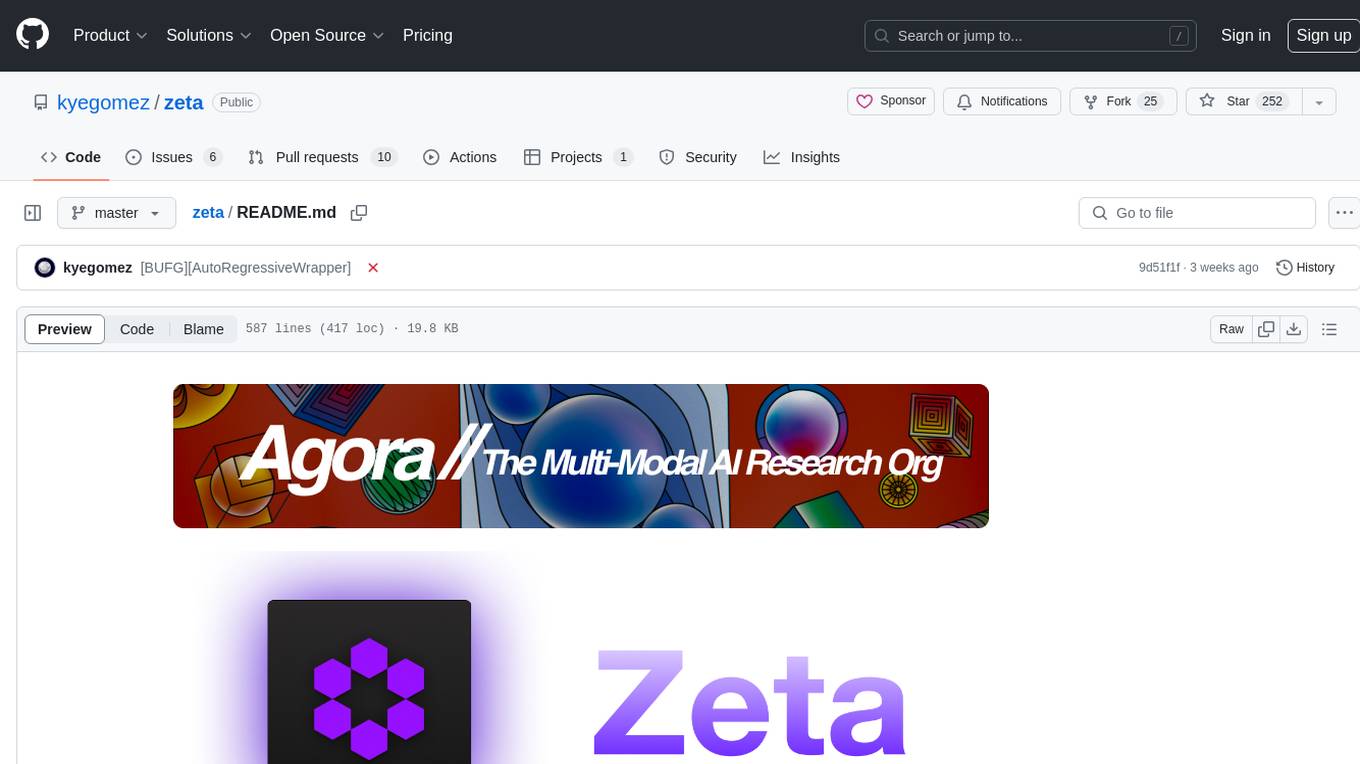
zeta
Zeta is a tool designed to build state-of-the-art AI models faster by providing modular, high-performance, and scalable building blocks. It addresses the common issues faced while working with neural nets, such as chaotic codebases, lack of modularity, and low performance modules. Zeta emphasizes usability, modularity, and performance, and is currently used in hundreds of models across various GitHub repositories. It enables users to prototype, train, optimize, and deploy the latest SOTA neural nets into production. The tool offers various modules like FlashAttention, SwiGLUStacked, RelativePositionBias, FeedForward, BitLinear, PalmE, Unet, VisionEmbeddings, niva, FusedDenseGELUDense, FusedDropoutLayerNorm, MambaBlock, Film, hyper_optimize, DPO, and ZetaCloud for different tasks in AI model development.
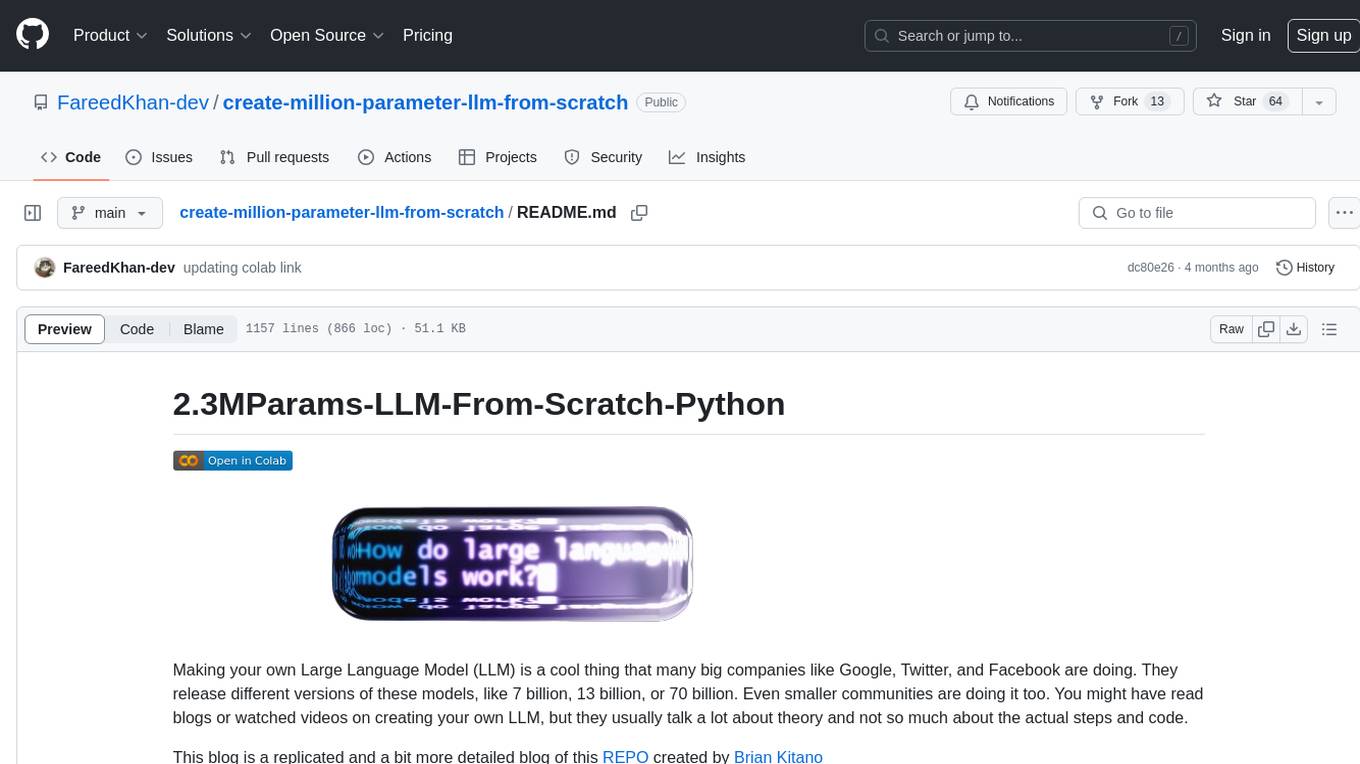
create-million-parameter-llm-from-scratch
The 'create-million-parameter-llm-from-scratch' repository provides a detailed guide on creating a Large Language Model (LLM) with 2.3 million parameters from scratch. The blog replicates the LLaMA approach, incorporating concepts like RMSNorm for pre-normalization, SwiGLU activation function, and Rotary Embeddings. The model is trained on a basic dataset to demonstrate the ease of creating a million-parameter LLM without the need for a high-end GPU.
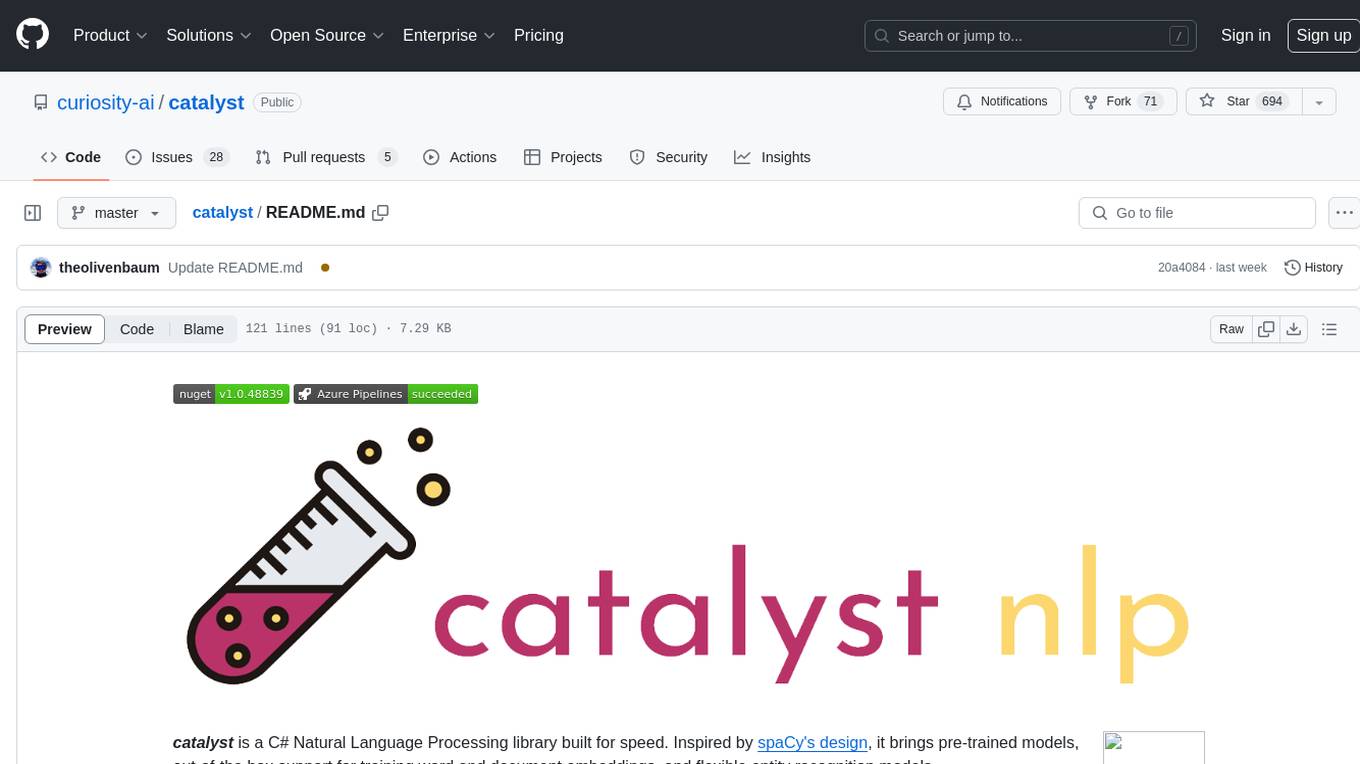
catalyst
Catalyst is a C# Natural Language Processing library designed for speed, inspired by spaCy's design. It provides pre-trained models, support for training word and document embeddings, and flexible entity recognition models. The library is fast, modern, and pure-C#, supporting .NET standard 2.0. It is cross-platform, running on Windows, Linux, macOS, and ARM. Catalyst offers non-destructive tokenization, named entity recognition, part-of-speech tagging, language detection, and efficient binary serialization. It includes pre-built models for language packages and lemmatization. Users can store and load models using streams. Getting started with Catalyst involves installing its NuGet Package and setting the storage to use the online repository. The library supports lazy loading of models from disk or online. Users can take advantage of C# lazy evaluation and native multi-threading support to process documents in parallel. Training a new FastText word2vec embedding model is straightforward, and Catalyst also provides algorithms for fast embedding search and dimensionality reduction.
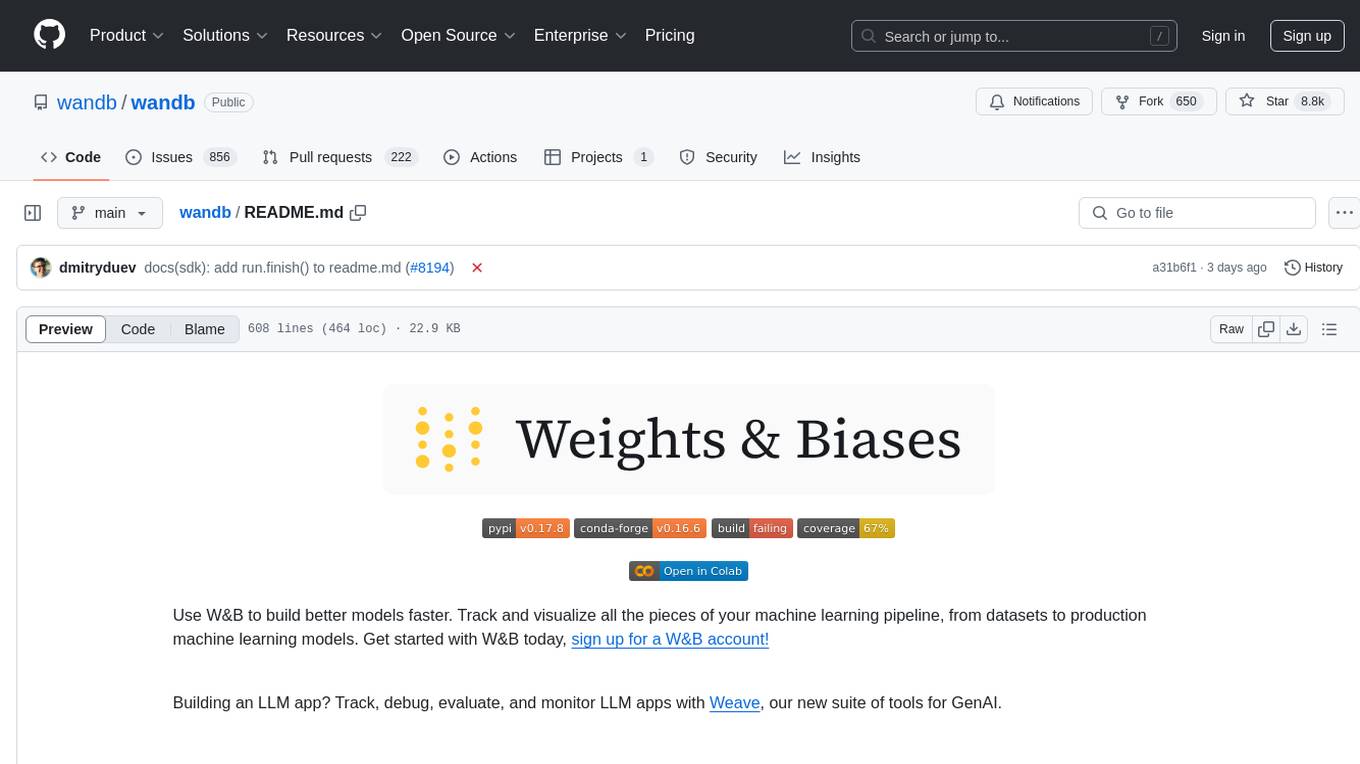
wandb
Weights & Biases (W&B) is a platform that helps users build better machine learning models faster by tracking and visualizing all components of the machine learning pipeline, from datasets to production models. It offers tools for tracking, debugging, evaluating, and monitoring machine learning applications. W&B provides integrations with popular frameworks like PyTorch, TensorFlow/Keras, Hugging Face Transformers, PyTorch Lightning, XGBoost, and Sci-Kit Learn. Users can easily log metrics, visualize performance, and compare experiments using W&B. The platform also supports hosting options in the cloud or on private infrastructure, making it versatile for various deployment needs.
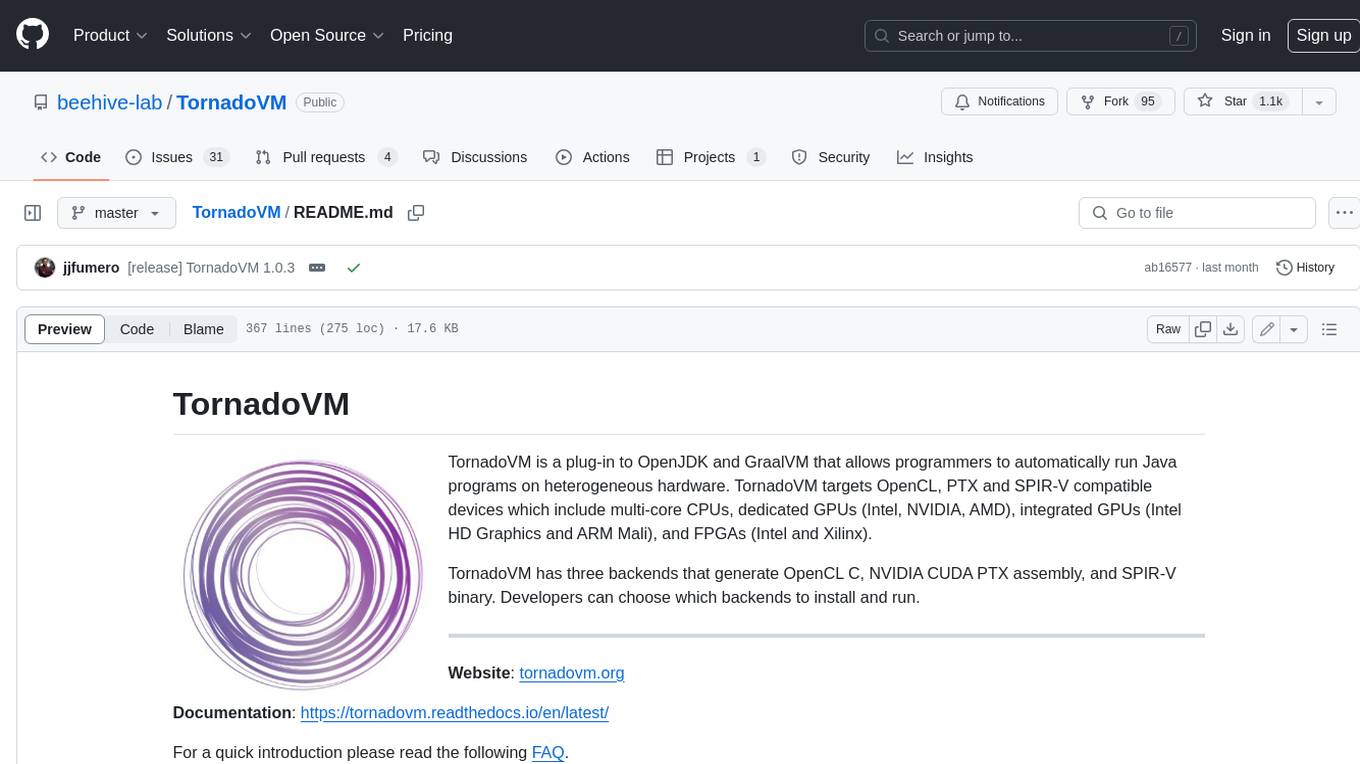
TornadoVM
TornadoVM is a plug-in to OpenJDK and GraalVM that allows programmers to automatically run Java programs on heterogeneous hardware. TornadoVM targets OpenCL, PTX and SPIR-V compatible devices which include multi-core CPUs, dedicated GPUs (Intel, NVIDIA, AMD), integrated GPUs (Intel HD Graphics and ARM Mali), and FPGAs (Intel and Xilinx).
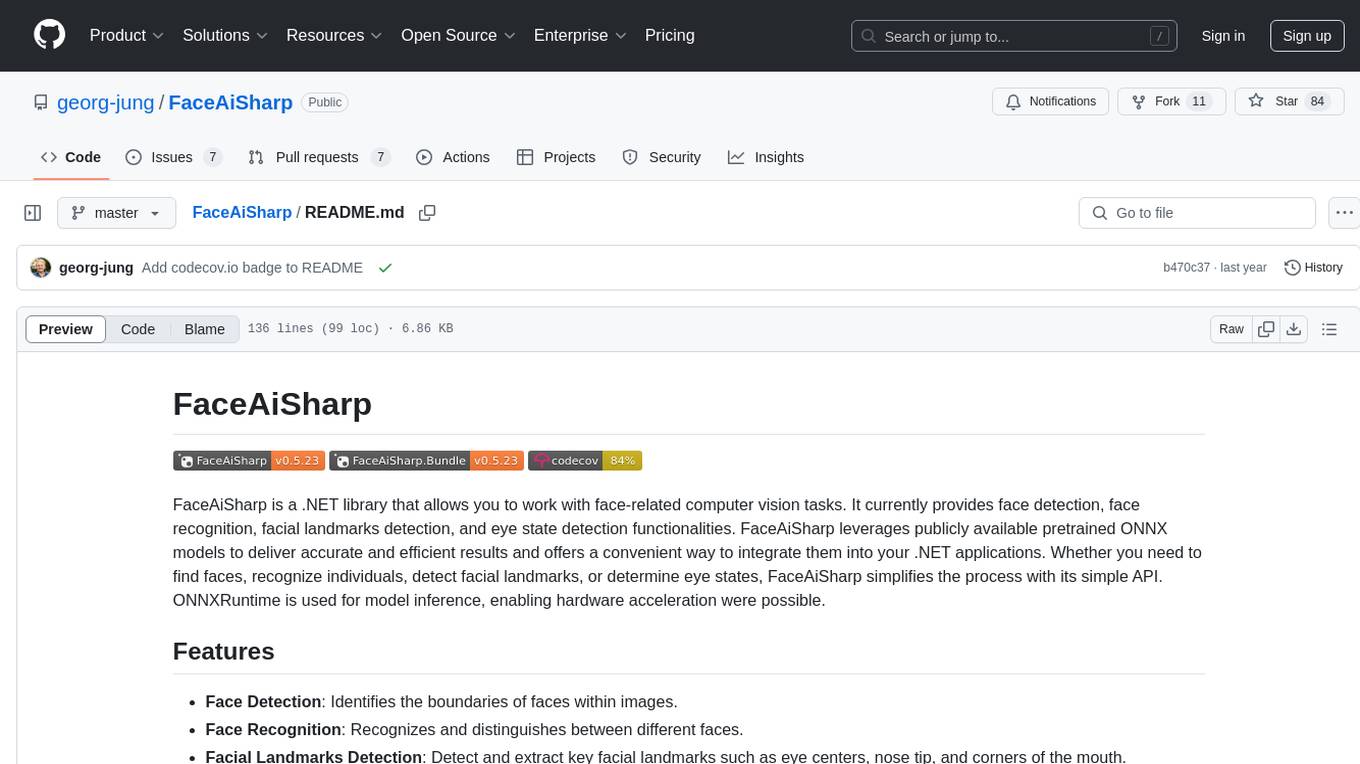
FaceAiSharp
FaceAiSharp is a .NET library designed for face-related computer vision tasks. It offers functionalities such as face detection, face recognition, facial landmarks detection, and eye state detection. The library utilizes pretrained ONNX models for accurate and efficient results, enabling users to integrate these capabilities into their .NET applications easily. With a focus on simplicity and performance, FaceAiSharp provides a local processing solution without relying on cloud services, supporting image-based face processing using ImageSharp. It is cross-platform compatible, supporting Windows, Linux, Android, and more.

simple-openai
Simple-OpenAI is a Java library that provides a simple way to interact with the OpenAI API. It offers consistent interfaces for various OpenAI services like Audio, Chat Completion, Image Generation, and more. The library uses CleverClient for HTTP communication, Jackson for JSON parsing, and Lombok to reduce boilerplate code. It supports asynchronous requests and provides methods for synchronous calls as well. Users can easily create objects to communicate with the OpenAI API and perform tasks like text-to-speech, transcription, image generation, and chat completions.
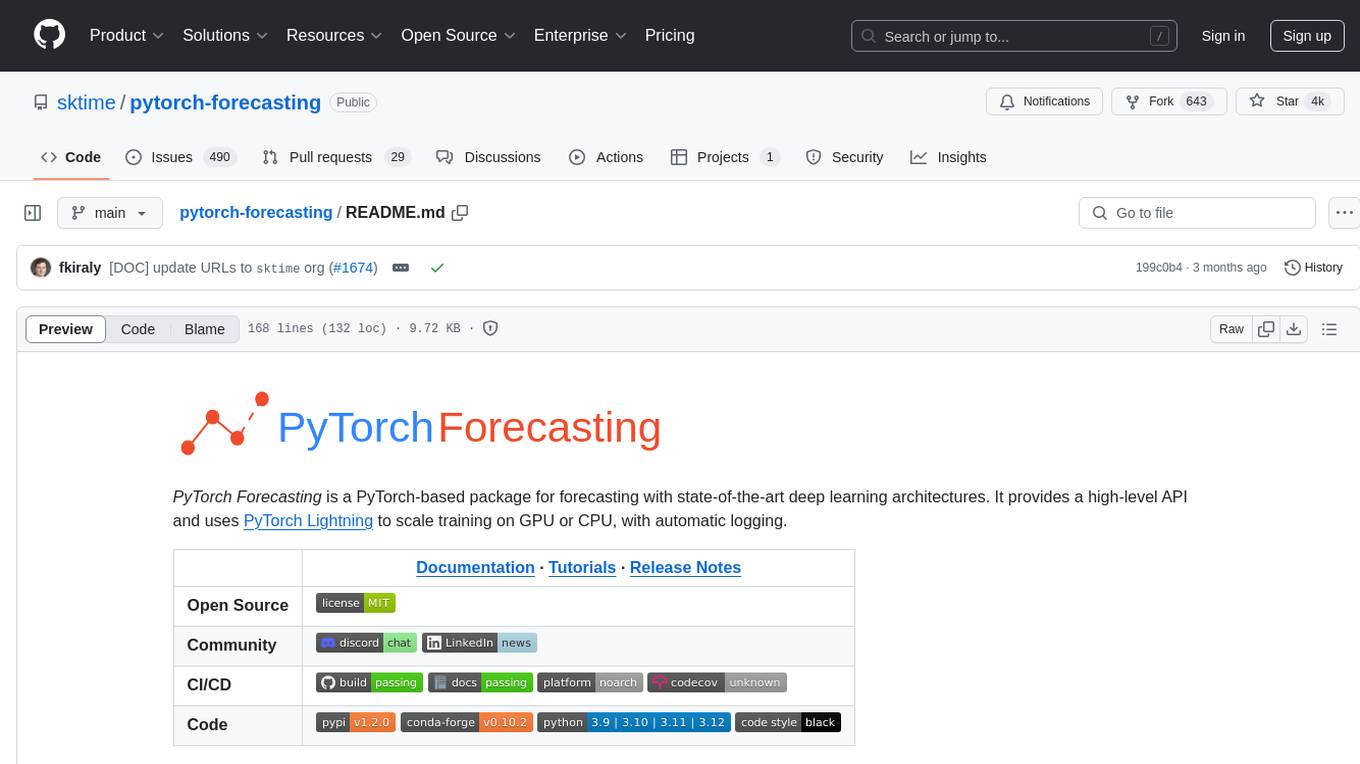
pytorch-forecasting
PyTorch Forecasting is a PyTorch-based package designed for state-of-the-art timeseries forecasting using deep learning architectures. It offers a high-level API and leverages PyTorch Lightning for efficient training on GPU or CPU with automatic logging. The package aims to simplify timeseries forecasting tasks by providing a flexible API for professionals and user-friendly defaults for beginners. It includes features such as a timeseries dataset class for handling data transformations, missing values, and subsampling, various neural network architectures optimized for real-world deployment, multi-horizon timeseries metrics, and hyperparameter tuning with optuna. Built on pytorch-lightning, it supports training on CPUs, single GPUs, and multiple GPUs out-of-the-box.
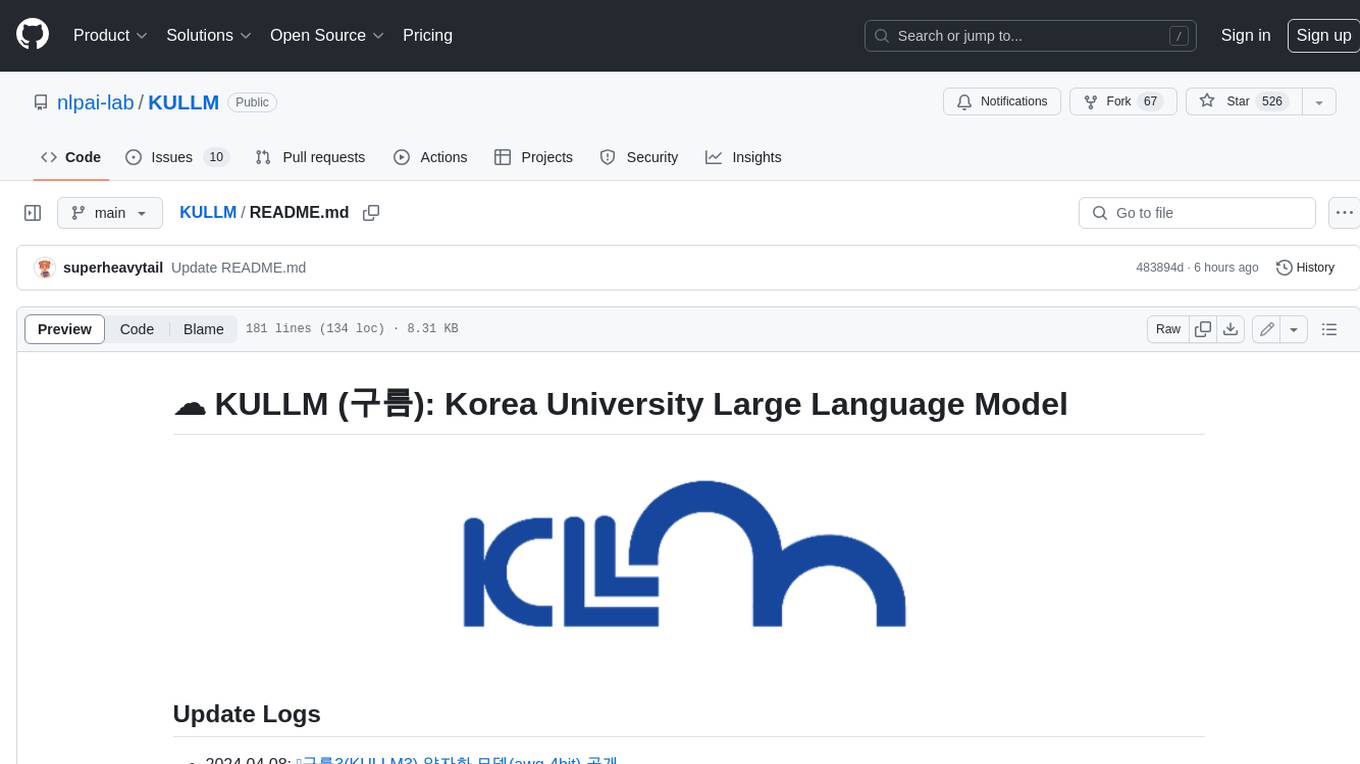
KULLM
KULLM (구름) is a Korean Large Language Model developed by Korea University NLP & AI Lab and HIAI Research Institute. It is based on the upstage/SOLAR-10.7B-v1.0 model and has been fine-tuned for instruction. The model has been trained on 8×A100 GPUs and is capable of generating responses in Korean language. KULLM exhibits hallucination and repetition phenomena due to its decoding strategy. Users should be cautious as the model may produce inaccurate or harmful results. Performance may vary in benchmarks without a fixed system prompt.
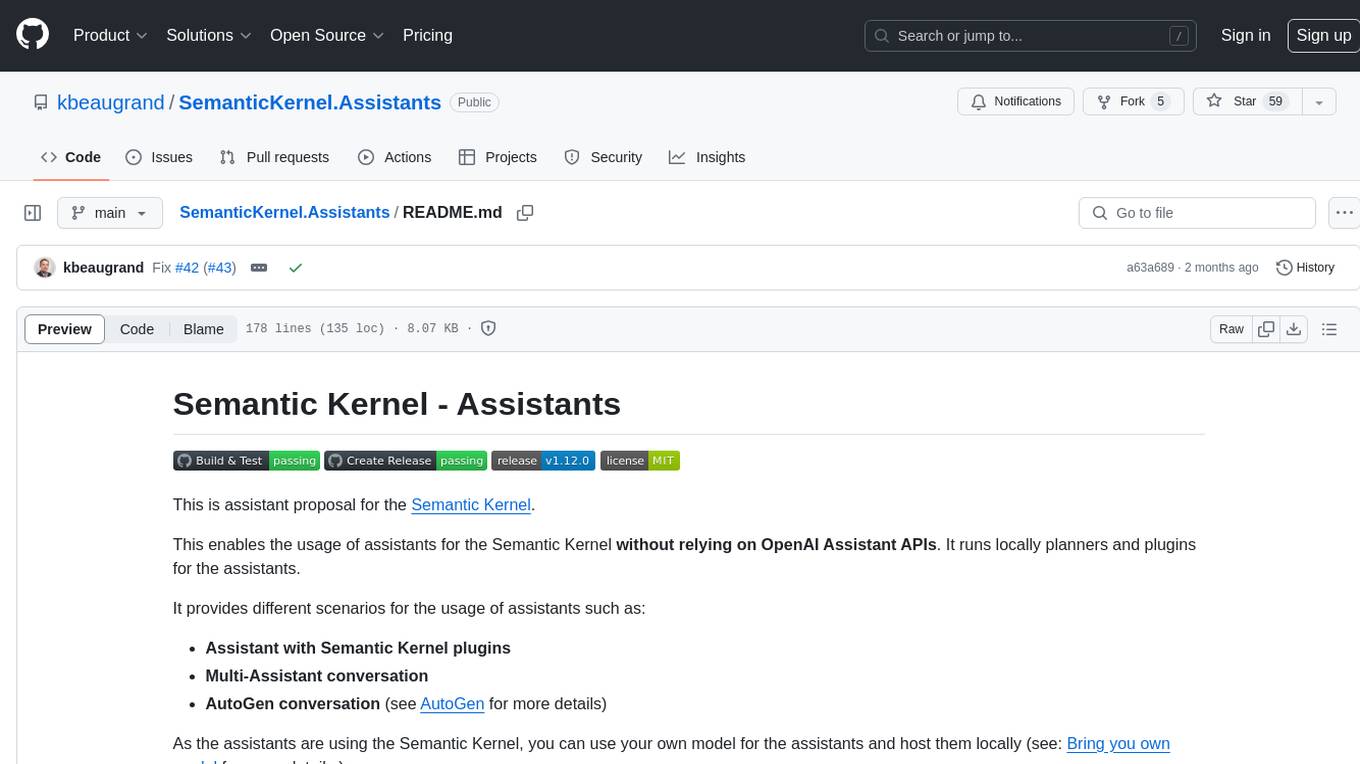
SemanticKernel.Assistants
This repository contains an assistant proposal for the Semantic Kernel, allowing the usage of assistants without relying on OpenAI Assistant APIs. It runs locally planners and plugins for the assistants, providing scenarios like Assistant with Semantic Kernel plugins, Multi-Assistant conversation, and AutoGen conversation. The Semantic Kernel is a lightweight SDK enabling integration of AI Large Language Models with conventional programming languages, offering functions like semantic functions, native functions, and embeddings-based memory. Users can bring their own model for the assistants and host them locally. The repository includes installation instructions, usage examples, and information on creating new conversation threads with the assistant.
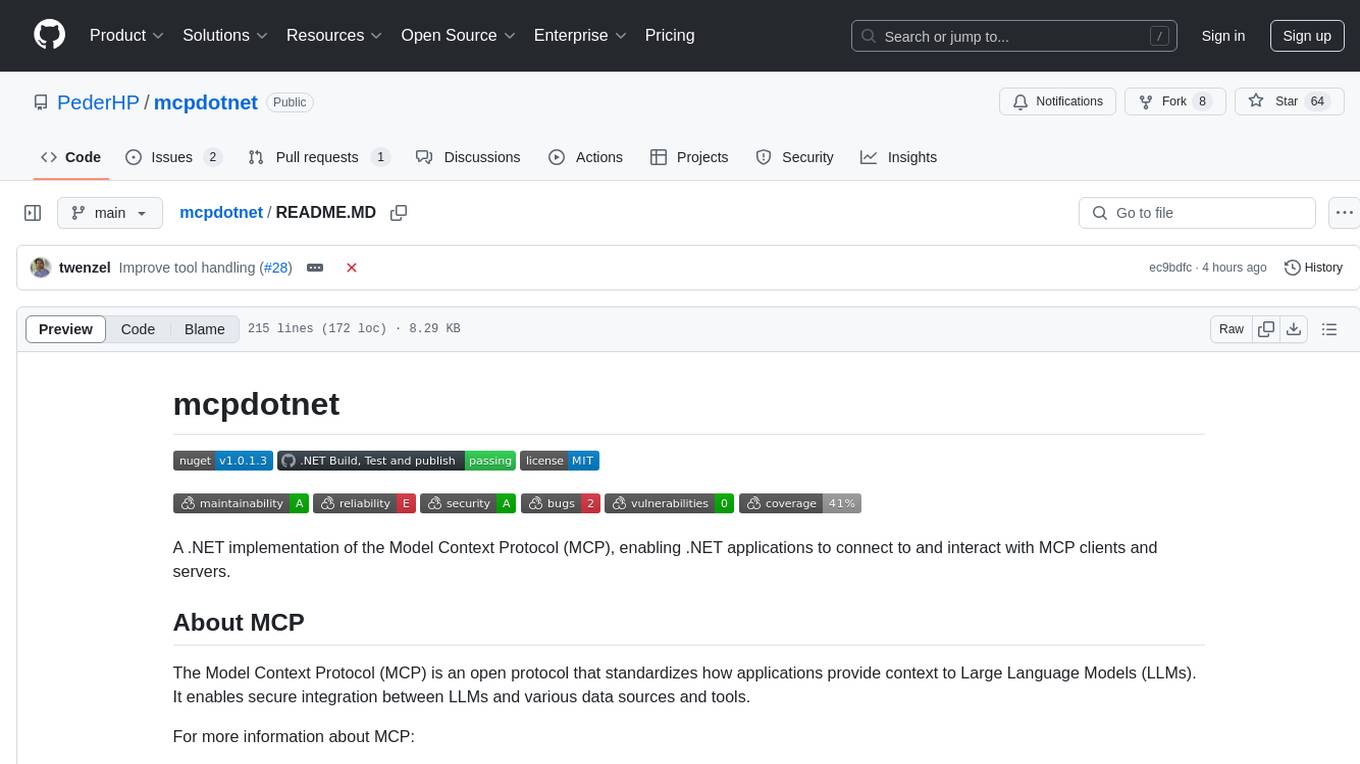
mcpdotnet
mcpdotnet is a .NET implementation of the Model Context Protocol (MCP), facilitating connections and interactions between .NET applications and MCP clients and servers. It aims to provide a clean, specification-compliant implementation with support for various MCP capabilities and transport types. The library includes features such as async/await pattern, logging support, and compatibility with .NET 8.0 and later. Users can create clients to use tools from configured servers and also create servers to register tools and interact with clients. The project roadmap includes expanding documentation, increasing test coverage, adding samples, performance optimization, SSE server support, and authentication.
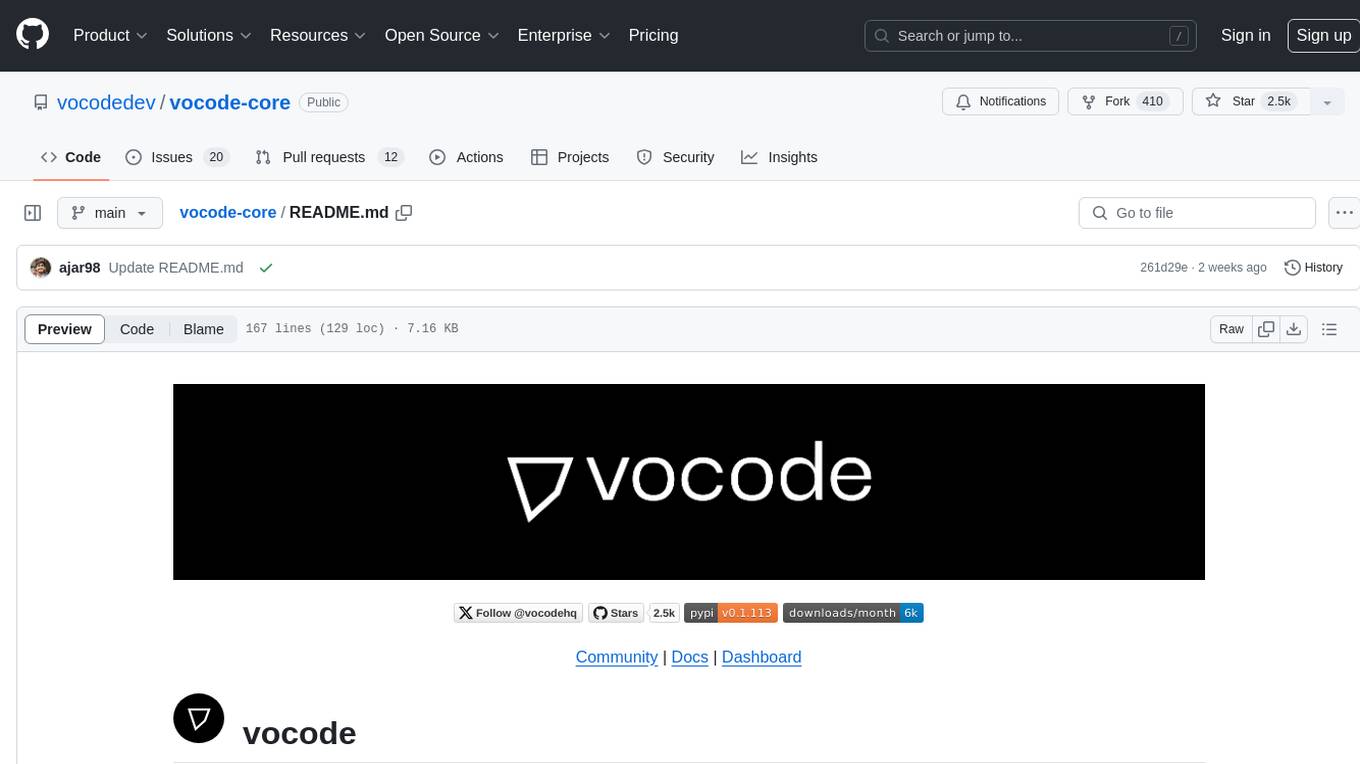
vocode-core
Vocode is an open source library that enables users to build voice-based LLM (Large Language Model) applications quickly and easily. With Vocode, users can create real-time streaming conversations with LLMs and deploy them for phone calls, Zoom meetings, and more. The library offers abstractions and integrations for transcription services, LLMs, and synthesis services, making it a comprehensive tool for voice-based app development. Vocode also provides out-of-the-box integrations with various services like AssemblyAI, OpenAI, Microsoft Azure, and more, allowing users to leverage these services seamlessly in their applications.
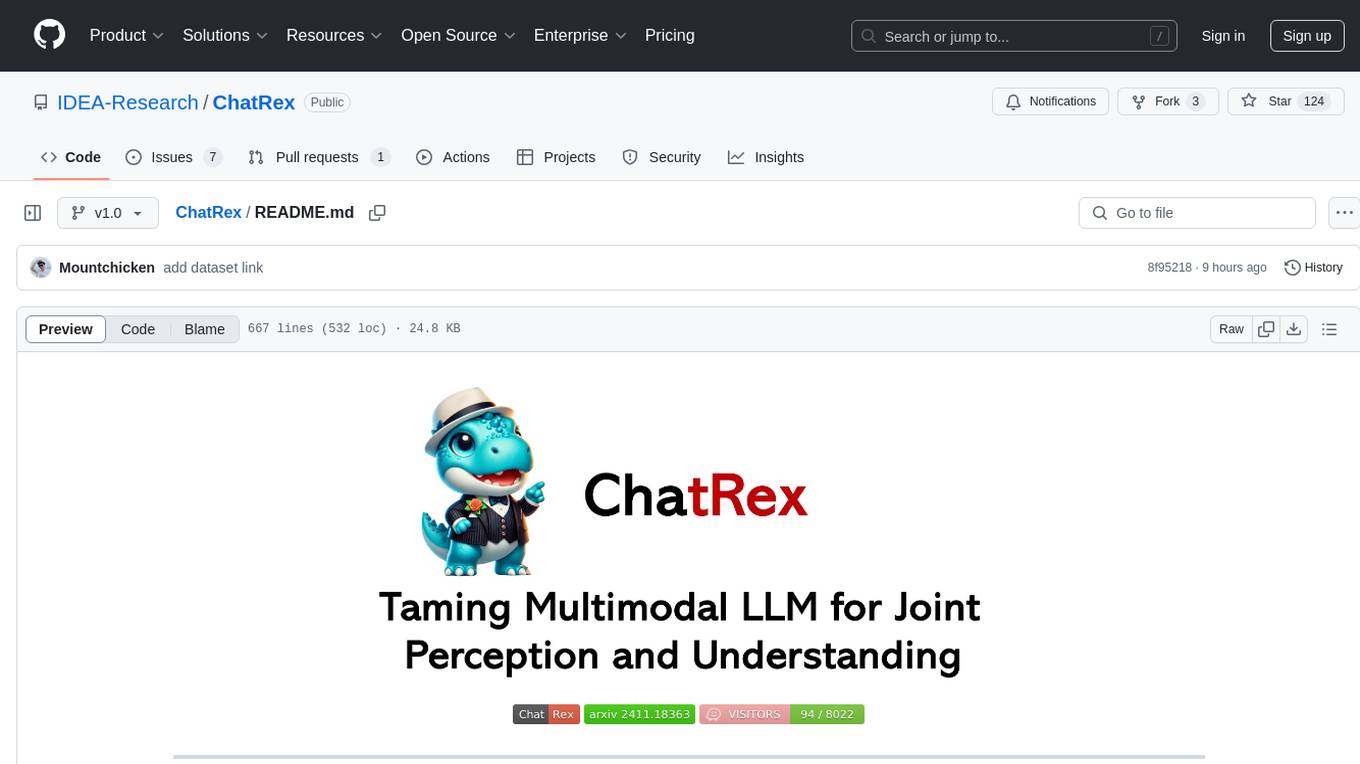
ChatRex
ChatRex is a Multimodal Large Language Model (MLLM) designed to seamlessly integrate fine-grained object perception and robust language understanding. By adopting a decoupled architecture with a retrieval-based approach for object detection and leveraging high-resolution visual inputs, ChatRex addresses key challenges in perception tasks. It is powered by the Rexverse-2M dataset with diverse image-region-text annotations. ChatRex can be applied to various scenarios requiring fine-grained perception, such as object detection, grounded conversation, grounded image captioning, and region understanding.
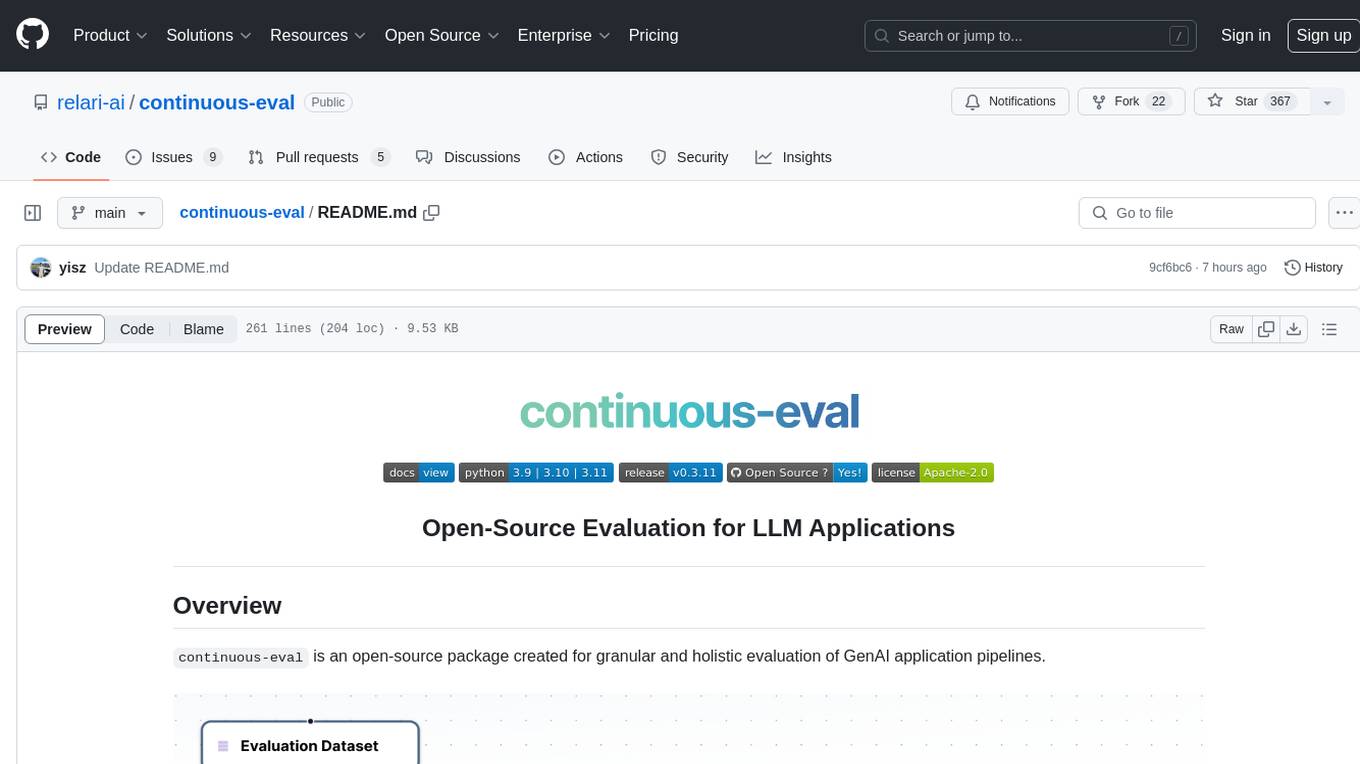
continuous-eval
Open-Source Evaluation for LLM Applications. `continuous-eval` is an open-source package created for granular and holistic evaluation of GenAI application pipelines. It offers modularized evaluation, a comprehensive metric library covering various LLM use cases, the ability to leverage user feedback in evaluation, and synthetic dataset generation for testing pipelines. Users can define their own metrics by extending the Metric class. The tool allows running evaluation on a pipeline defined with modules and corresponding metrics. Additionally, it provides synthetic data generation capabilities to create user interaction data for evaluation or training purposes.
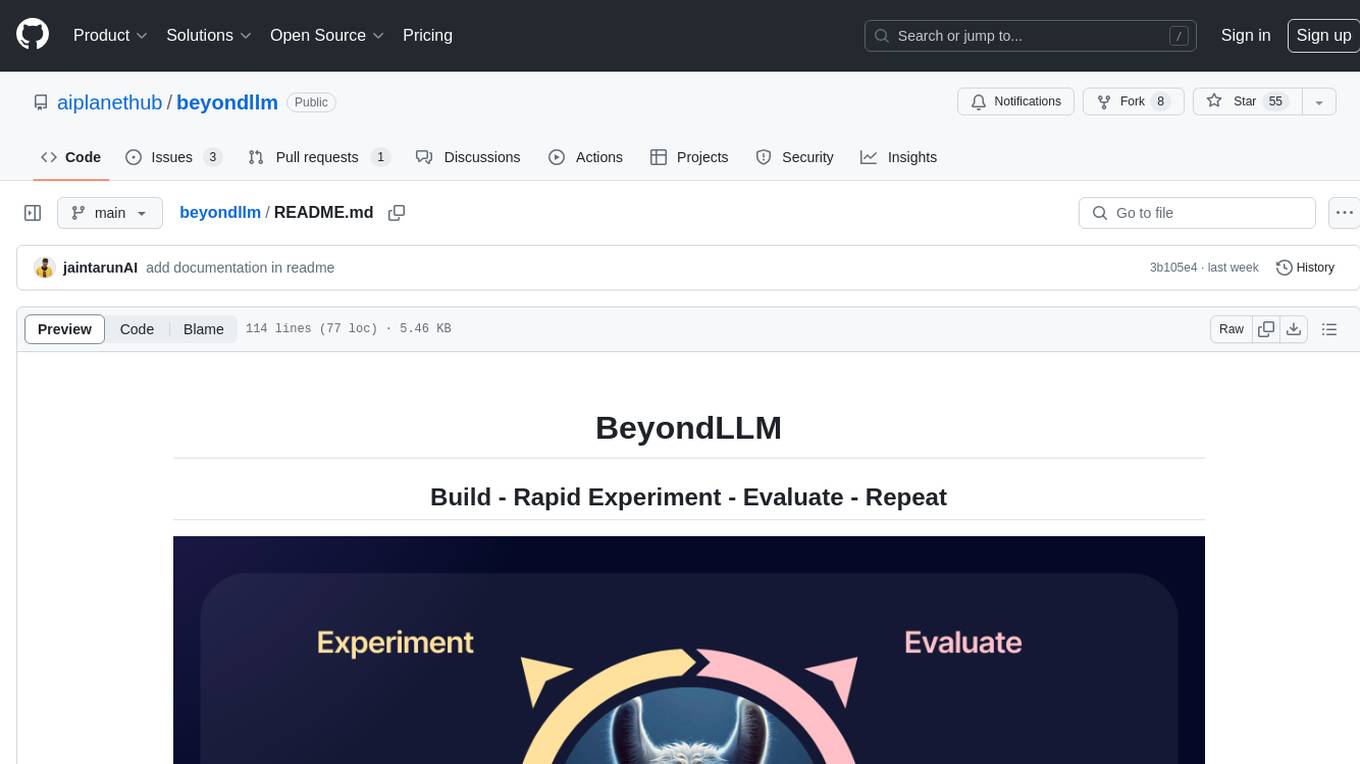
beyondllm
Beyond LLM offers an all-in-one toolkit for experimentation, evaluation, and deployment of Retrieval-Augmented Generation (RAG) systems. It simplifies the process with automated integration, customizable evaluation metrics, and support for various Large Language Models (LLMs) tailored to specific needs. The aim is to reduce LLM hallucination risks and enhance reliability.
For similar tasks
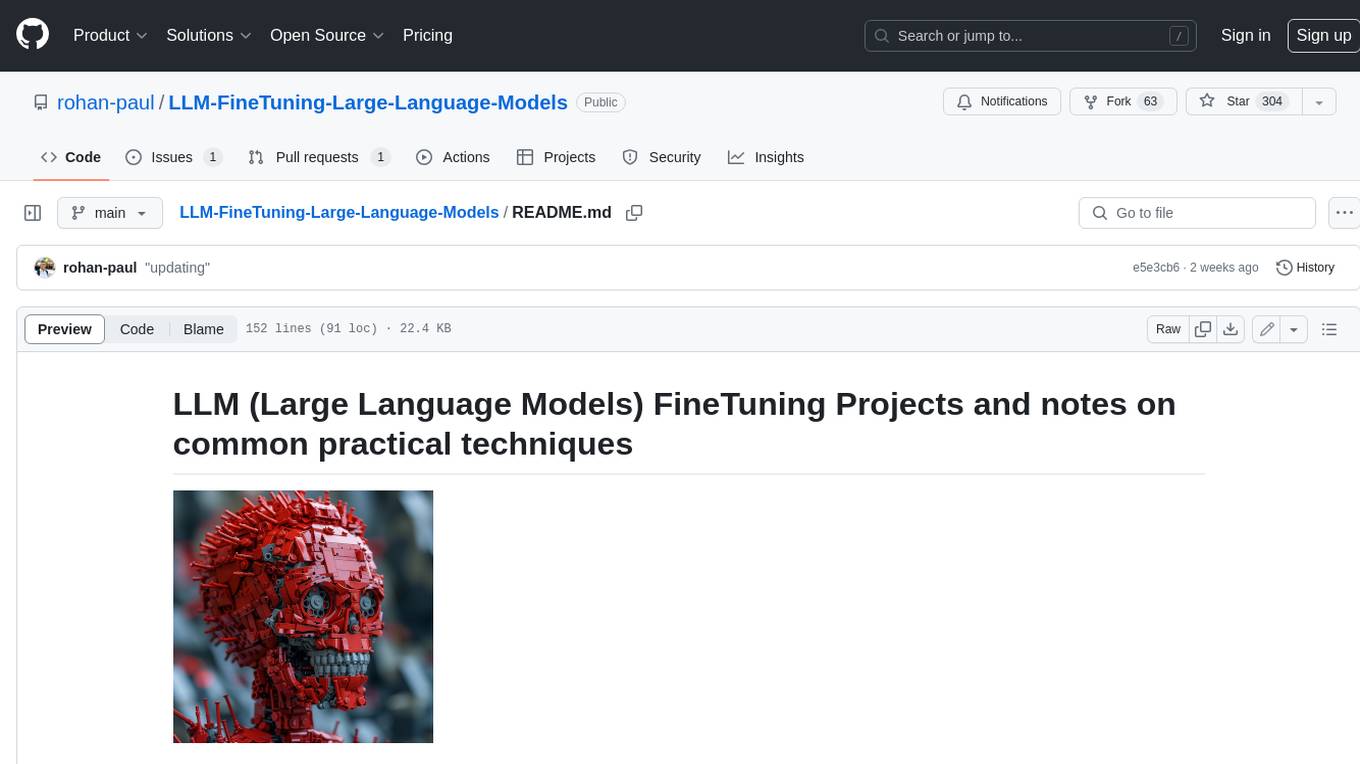
LLM-FineTuning-Large-Language-Models
This repository contains projects and notes on common practical techniques for fine-tuning Large Language Models (LLMs). It includes fine-tuning LLM notebooks, Colab links, LLM techniques and utils, and other smaller language models. The repository also provides links to YouTube videos explaining the concepts and techniques discussed in the notebooks.

RWKV-LM
RWKV is an RNN with Transformer-level LLM performance, which can also be directly trained like a GPT transformer (parallelizable). And it's 100% attention-free. You only need the hidden state at position t to compute the state at position t+1. You can use the "GPT" mode to quickly compute the hidden state for the "RNN" mode. So it's combining the best of RNN and transformer - **great performance, fast inference, saves VRAM, fast training, "infinite" ctx_len, and free sentence embedding** (using the final hidden state).
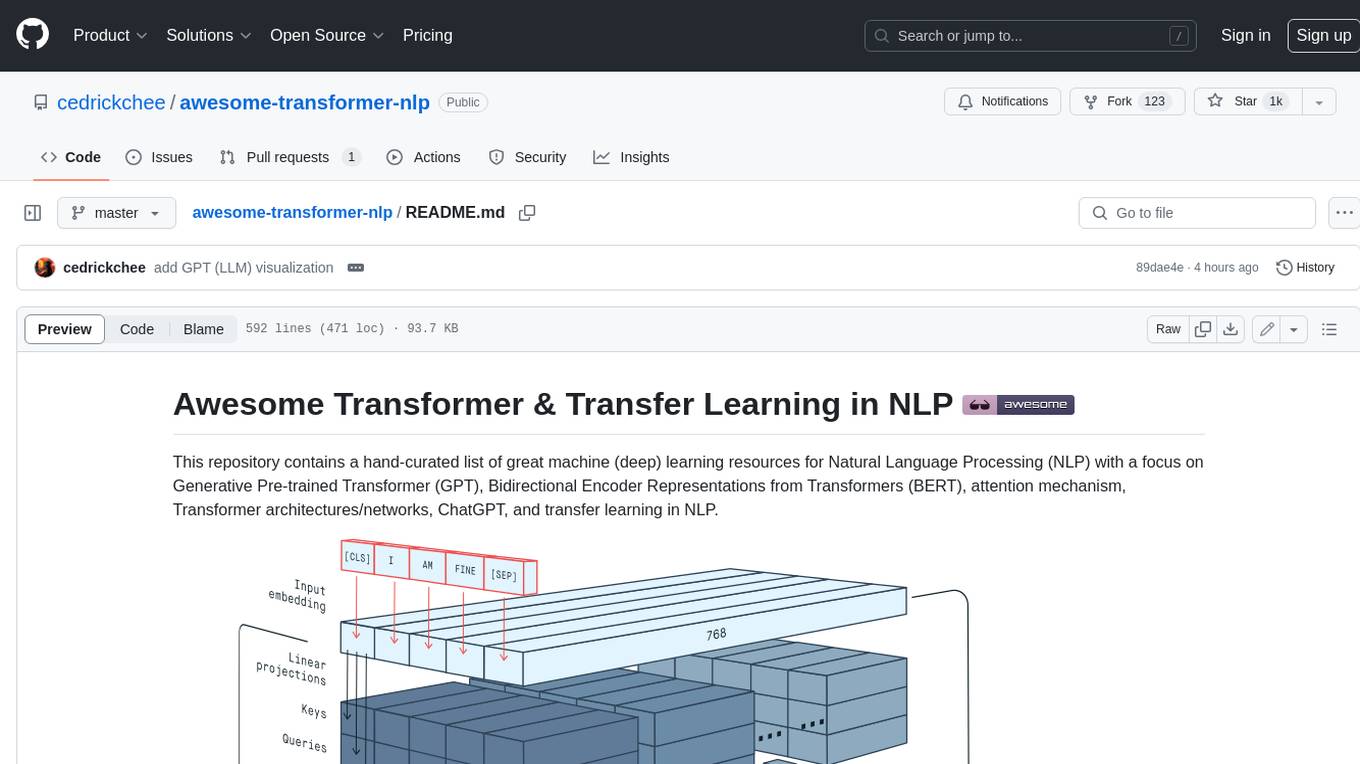
awesome-transformer-nlp
This repository contains a hand-curated list of great machine (deep) learning resources for Natural Language Processing (NLP) with a focus on Generative Pre-trained Transformer (GPT), Bidirectional Encoder Representations from Transformers (BERT), attention mechanism, Transformer architectures/networks, Chatbot, and transfer learning in NLP.
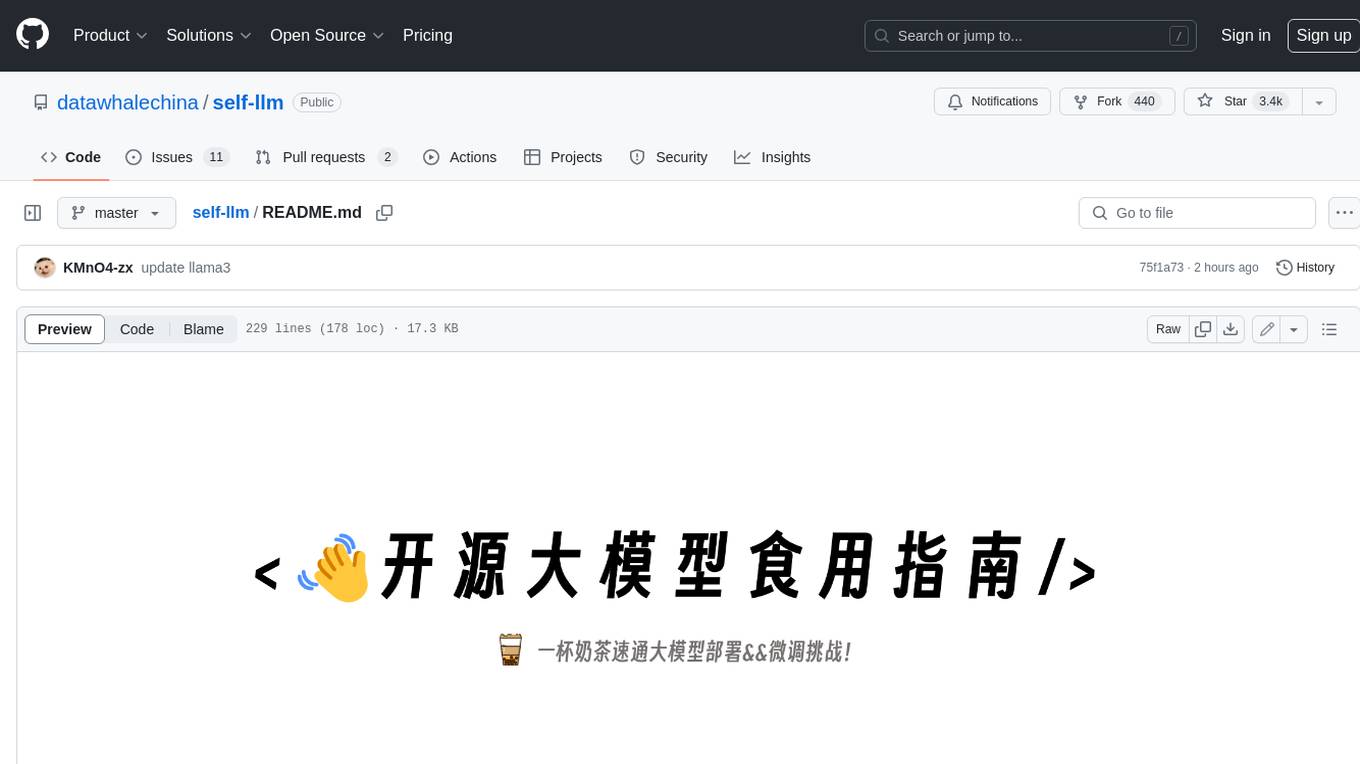
self-llm
This project is a Chinese tutorial for domestic beginners based on the AutoDL platform, providing full-process guidance for various open-source large models, including environment configuration, local deployment, and efficient fine-tuning. It simplifies the deployment, use, and application process of open-source large models, enabling more ordinary students and researchers to better use open-source large models and helping open and free large models integrate into the lives of ordinary learners faster.
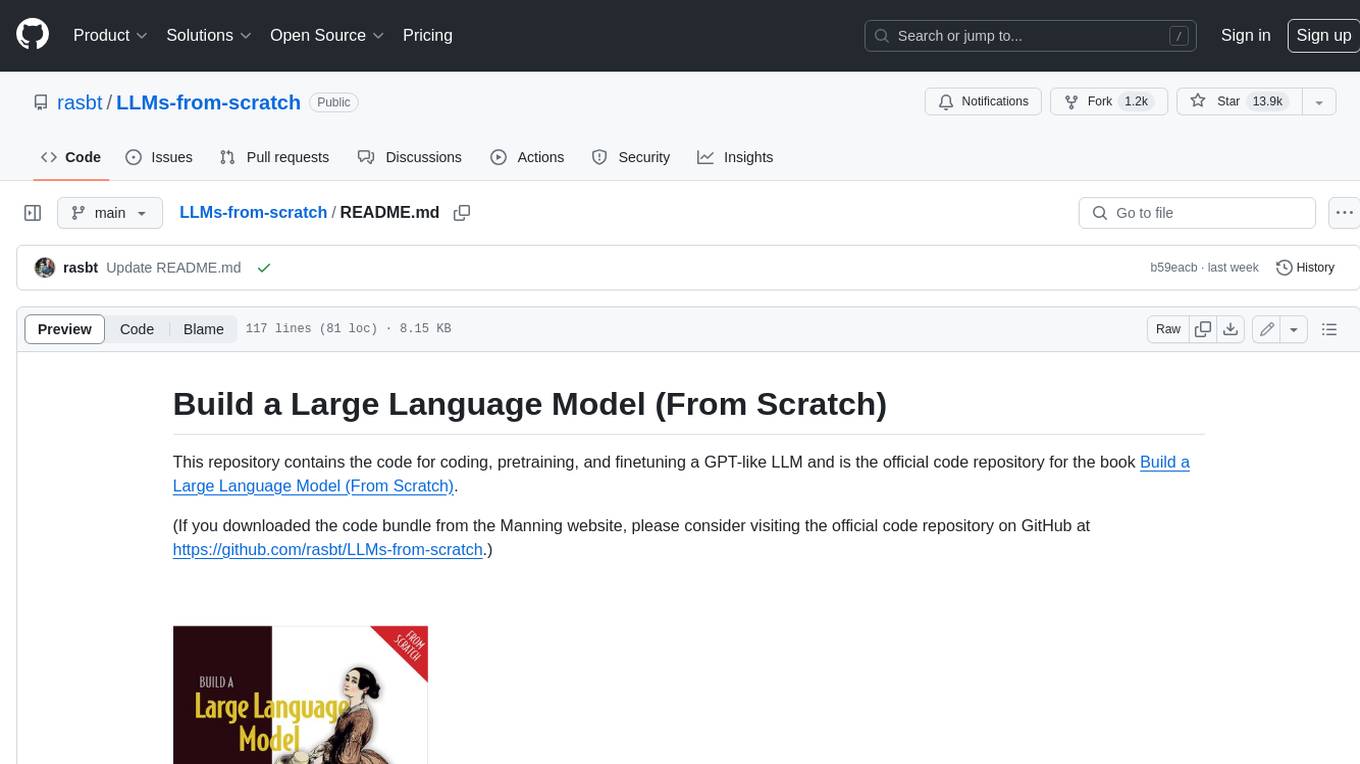
LLMs-from-scratch
This repository contains the code for coding, pretraining, and finetuning a GPT-like LLM and is the official code repository for the book Build a Large Language Model (From Scratch). In _Build a Large Language Model (From Scratch)_, you'll discover how LLMs work from the inside out. In this book, I'll guide you step by step through creating your own LLM, explaining each stage with clear text, diagrams, and examples. The method described in this book for training and developing your own small-but-functional model for educational purposes mirrors the approach used in creating large-scale foundational models such as those behind ChatGPT.
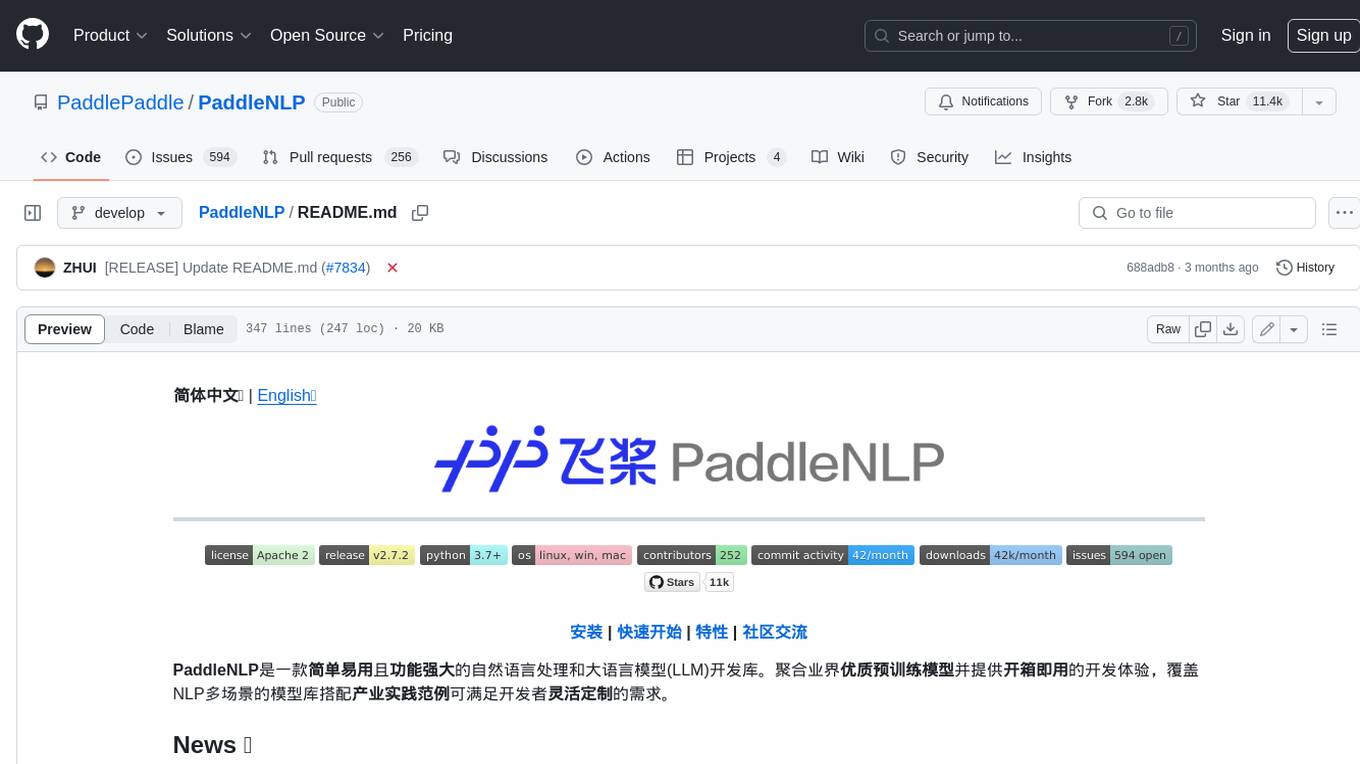
PaddleNLP
PaddleNLP is an easy-to-use and high-performance NLP library. It aggregates high-quality pre-trained models in the industry and provides out-of-the-box development experience, covering a model library for multiple NLP scenarios with industry practice examples to meet developers' flexible customization needs.
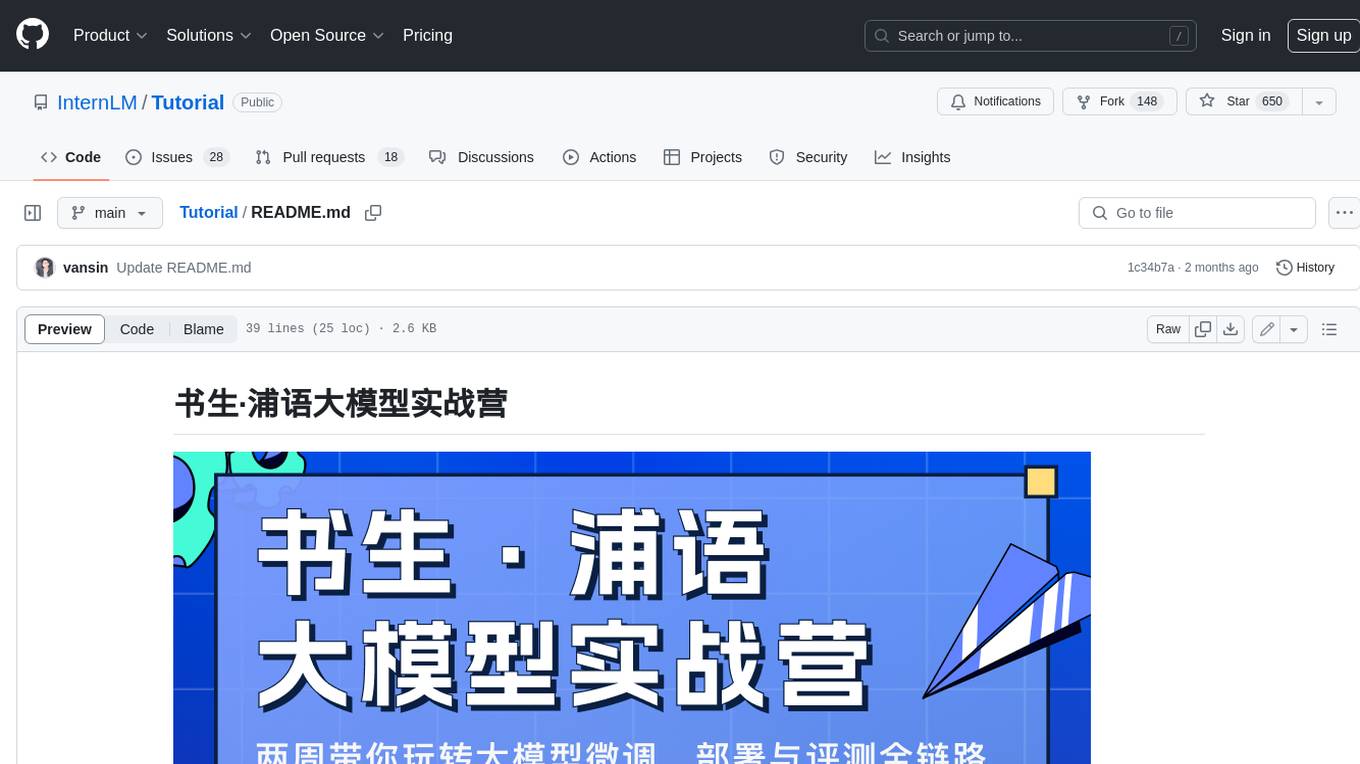
Tutorial
The Bookworm·Puyu large model training camp aims to promote the implementation of large models in more industries and provide developers with a more efficient platform for learning the development and application of large models. Within two weeks, you will learn the entire process of fine-tuning, deploying, and evaluating large models.

LLM-Finetune-Guide
This project provides a comprehensive guide to fine-tuning large language models (LLMs) with efficient methods like LoRA and P-tuning V2. It includes detailed instructions, code examples, and performance benchmarks for various LLMs and fine-tuning techniques. The guide also covers data preparation, evaluation, prediction, and running inference on CPU environments. By leveraging this guide, users can effectively fine-tune LLMs for specific tasks and applications.
For similar jobs

weave
Weave is a toolkit for developing Generative AI applications, built by Weights & Biases. With Weave, you can log and debug language model inputs, outputs, and traces; build rigorous, apples-to-apples evaluations for language model use cases; and organize all the information generated across the LLM workflow, from experimentation to evaluations to production. Weave aims to bring rigor, best-practices, and composability to the inherently experimental process of developing Generative AI software, without introducing cognitive overhead.

agentcloud
AgentCloud is an open-source platform that enables companies to build and deploy private LLM chat apps, empowering teams to securely interact with their data. It comprises three main components: Agent Backend, Webapp, and Vector Proxy. To run this project locally, clone the repository, install Docker, and start the services. The project is licensed under the GNU Affero General Public License, version 3 only. Contributions and feedback are welcome from the community.

oss-fuzz-gen
This framework generates fuzz targets for real-world `C`/`C++` projects with various Large Language Models (LLM) and benchmarks them via the `OSS-Fuzz` platform. It manages to successfully leverage LLMs to generate valid fuzz targets (which generate non-zero coverage increase) for 160 C/C++ projects. The maximum line coverage increase is 29% from the existing human-written targets.

LLMStack
LLMStack is a no-code platform for building generative AI agents, workflows, and chatbots. It allows users to connect their own data, internal tools, and GPT-powered models without any coding experience. LLMStack can be deployed to the cloud or on-premise and can be accessed via HTTP API or triggered from Slack or Discord.

VisionCraft
The VisionCraft API is a free API for using over 100 different AI models. From images to sound.

kaito
Kaito is an operator that automates the AI/ML inference model deployment in a Kubernetes cluster. It manages large model files using container images, avoids tuning deployment parameters to fit GPU hardware by providing preset configurations, auto-provisions GPU nodes based on model requirements, and hosts large model images in the public Microsoft Container Registry (MCR) if the license allows. Using Kaito, the workflow of onboarding large AI inference models in Kubernetes is largely simplified.

PyRIT
PyRIT is an open access automation framework designed to empower security professionals and ML engineers to red team foundation models and their applications. It automates AI Red Teaming tasks to allow operators to focus on more complicated and time-consuming tasks and can also identify security harms such as misuse (e.g., malware generation, jailbreaking), and privacy harms (e.g., identity theft). The goal is to allow researchers to have a baseline of how well their model and entire inference pipeline is doing against different harm categories and to be able to compare that baseline to future iterations of their model. This allows them to have empirical data on how well their model is doing today, and detect any degradation of performance based on future improvements.

Azure-Analytics-and-AI-Engagement
The Azure-Analytics-and-AI-Engagement repository provides packaged Industry Scenario DREAM Demos with ARM templates (Containing a demo web application, Power BI reports, Synapse resources, AML Notebooks etc.) that can be deployed in a customer’s subscription using the CAPE tool within a matter of few hours. Partners can also deploy DREAM Demos in their own subscriptions using DPoC.


















